
Field Projects: 2005-2011

| CASTALIAN SPRINGS ARCHAEOLOGICAL PROJECT Field Projects: 2005-2011
|
On June 5, we will be conducting an orientation lecture from 9:00 am until 2:00 pm on the MTSU campus.
We will begin on-site preparations on June 6.
"Starting up" an archaeological project is a tedious and time-consuming
task that rarely makes The News. It's only at the end of the project --
if you find something -- that makes all of the preparation and work
worthwhile. Preparations for our summer field project this year started several
months ago -- but the real work began in setting up our field camp, lab,
and excavation area several weeks ago in mid-May. Thanks to the
assistance of the McKee family, our excavation area was bushhogged in
preparation for the "digs." After that, John Garrott and Lee Myers
assisted in getting it mowed down, raked, and mowed again. Note the
four-foot high grass at the edge of our excavation area below -- without
the help from community folks, our excavation area would have looked the
same today! Today, we started off at 8:00 am getting our field lab cleaned out,
setting up tables and chairs, and preparing for our next five weeks of
work. Our tasks also included hauling and organizing the half dozen
truckloads of equipment and supplies that will keep us working for the
next month plus. Thanks to the patience and hard work of the students -- we were half a
day ahead of schedule by the afternoon. We completed laying out our
north-south and east-west grid system that will serve us throughout the
rest of June and early July. By mid-afternoon, students had received their training in how to lay
out their excavation units -- placing nails and twine precisely on the
corners of two-meter square excavation units. Before we closed up for the day at 4:30 pm, we had already begun
stripping the sod from six excavation units looking for evidence of the
stockade or wall that surrounded this ancient town around A.D. 1250 or
so. On Wednesday, we will be moving "full speed ahead" on investigating
this incredibly important prehistoric Native American town site with
modern archaeological techniques.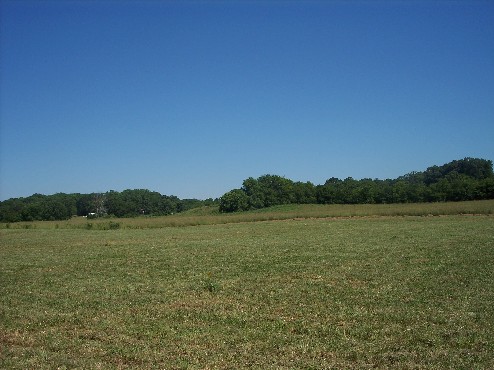
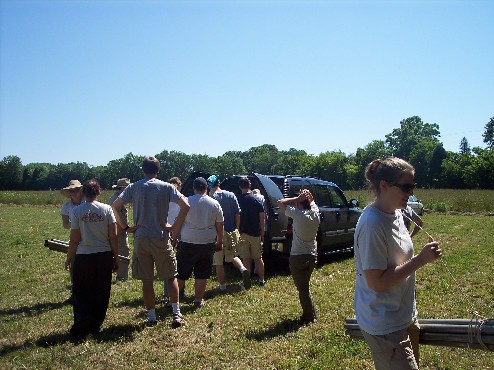
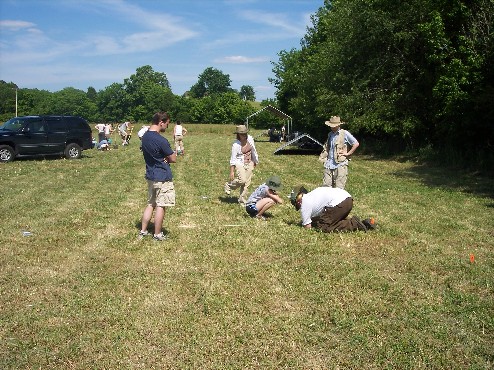
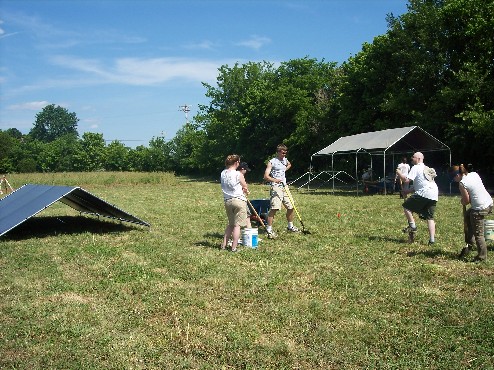
Today, Emily Beahm (field assistant) and I arrived on site about 7:30
am from Murfreesboro to unload equipment. Our excavation units are
covered in black plastic to protect them from the elements (and wandering
deer!). Our team is divided into six three-person "crews" -- each working on a
separate excavation unit. Our excavation units are squares two-meters on
a side -- all carefully tied into our recording system. Our first goal
during the "dig" is to complete a long excavation trench that will
hopefully cross the ancient wall that once surrounded the town. This wall
was described in 1820 by R.E.W. Earl, the first known person to "dig" at
the site. Today, we managed to complete the first
10-centimeter level in most of our excavations. Four of our crews are
working close together on different segments of our trench...
While another two crews are working about twenty meters to the
west... As always, we don't expect to find a tremendous amount of important
artifacts in the first ten centimeters -- this is the most heavily
disturbed portion of the "plow zone." As a plowed cornfield for many
decades (until the 1970s), this upper level of soil has been turned and
churned many many times over the past 200 years. The remnants of the
relics left behind by the folks that lived here 1000 years ago have been
battered and broken by the plow and tractor. Despite the plowing, we are already turning up tiny fragments of
ancient pottery, flint chips, broken stone tools, and the teeth of
animals butchered and eaten over 1000 years ago. As we proceed into
"Level 2" (another ten centimeters or about four inches) we expect the
pieces of pottery, flint, and other items to increase in size -- while
the plow general reaches 8-10 inches around here, the disturbance and
breakage becomes less and less the deeper we go. Our first week is always relatively slow and perhaps not too exciting
for outside observers -- students are "learning the ropes" of how to
excavate, recover artifacts, make records, and get into the daily routine.
As the days pass and we delve deeper into the mysteries of the Castalian
Springs Mounds, we feel certain our progress reports will bring exciting
discoveries. Keep checking back!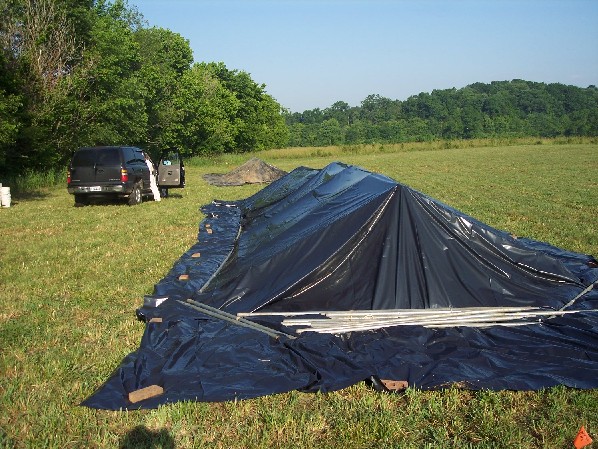
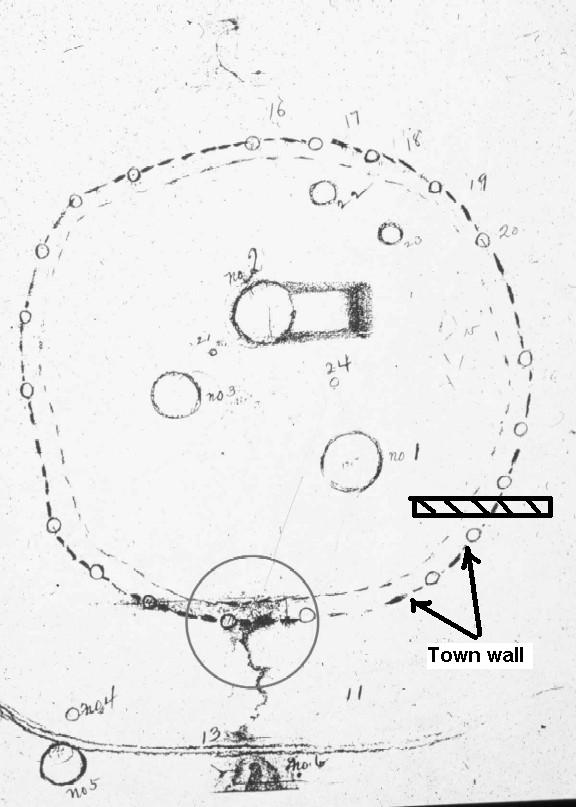

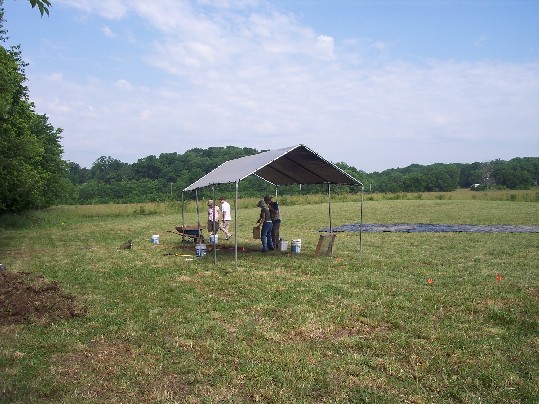
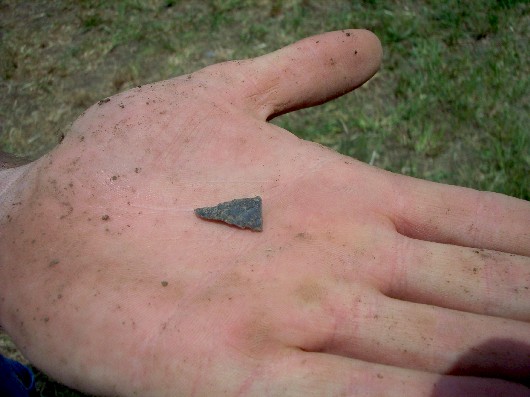
The day began very pleasantly -- uncommonly cool for June and remained
quite comfortable all day. At about 7:00 am, the morning sun streaming
through the trees lit up the dew-covered spiderwebs throughout the high
grass near our excavation area. While pleasantly cool for this time of year (and remarkably
"un-humid"), the winds were gusty and our tent shelters occasionally were
tempted to demonstrate their additional skills as airplanes. Rather than
spending the time to stake them down, we decided to work without them for
most of the day. Our project is -- first and foremost -- a course designed to train
students in the methods, skills, and techniques they need to perform as
professional archaeologists in future careers. As such, our progress
during the first week is always slow from the "outside perspective" --
much of our time is taken up with individualized instruction. But, our
crews are doing a super job of learning fast, asking questions, and making
this intensive experiential learning process a success. Today, we focused on two specific areas -- surveying equipment and
excavation technique. While our "site grid" provides the two dimensions
of north-south and east-west, archaeological record keeping requires
careful control in three-dimensions (including elevation or depth). We
use a transit to maintain that third dimension. Below Jesse records
elevation measurements at the transit while Rebekah holds the stadia rod
in the distance at our elevation benchmark. Students also continued practicing their excavation skills -- learning
to excavate squares with flat bottoms and straight sides. Below Lacey and
Robin are finishing the cleanup on Level 2 of their unit. Elsewhere on the site, Rebekah checks the depths of their second level
to make sure they are ready to close out the paperwork on it and start on
Level 3. During most of they day, students also experienced another common
feature of archaeological work -- curious sightseers. We had a number of
visitors from the local community today checking out what we were doing.
Among the curious sightseers were some local folks with more ominous
interests. Noting some twenty large mammals (in other words -- our
archaeological team!) staying fairly still in the middle of a field, a
dozen of so of the local buzzards soared above us most of the day. A few
of them landed nearby to take a closer look. Unfortunately for them, but fortunately for us, it isn't hot and humid
enough (yet) for us to provide a snack. Later in the afternoon, we were visited by a local newspaper reporter
who examined our excavations and discussed the project with the students.
Below, he is chatting with Richard and Natalie while Beth works on her
sidewalls at the lower left. At right, Meagan is continuing to level
their excavation area. While we are still working in those upper plowed areas -- as we
proceeded "deeper" today, we began to encounter increasing amounts of
artifacts left by native peoples over 800 years ago. Fragments of
shell-tempered pottery are becoming more common and larger, along with
small triangular "arrow points." In most of our excavations, another 10
centimeters or so will bring us down on top of the undisturbed "midden" or
garbage deposits of the people who once inhabited this town. As the students become more confident with their newfound techniques
and skills (and more familiar with the "routines"), we begin to move more
quickly with our work.
After work, a few of us checked out the swallow population in the main
hall of one of the barns on the property. We have high hopes for Friday and Saturday as we proceed beneath the
plowed areas into "undisturbed archaeology. Join us again tomorrow (and then next week) to keep up with our
discoveries!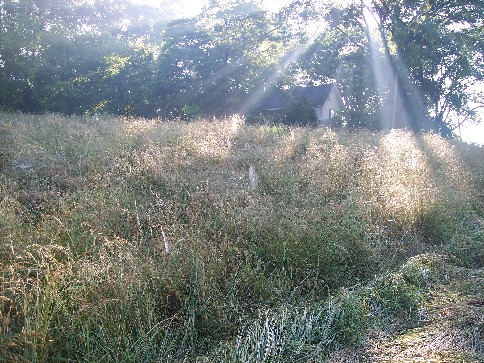
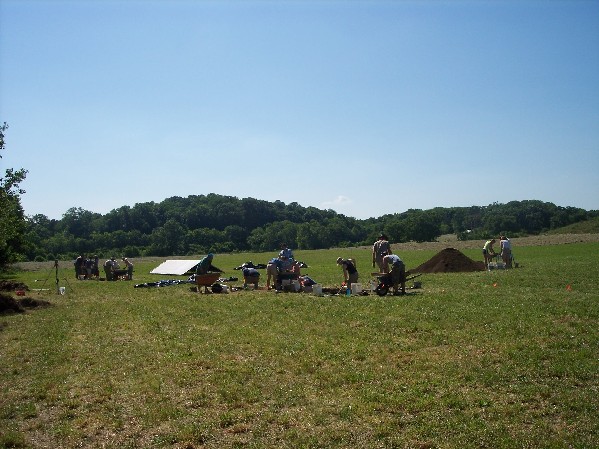
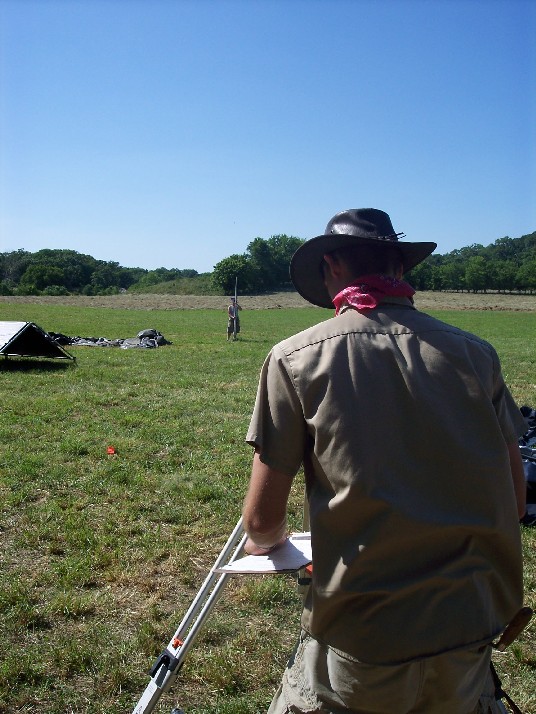
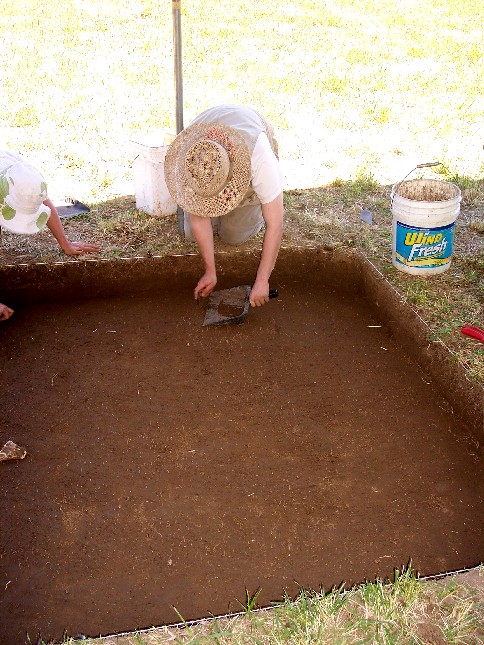

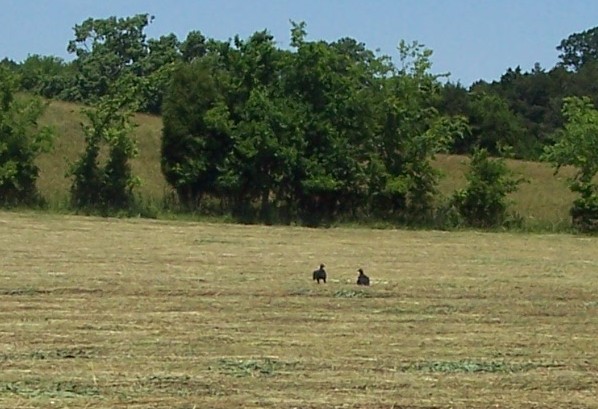


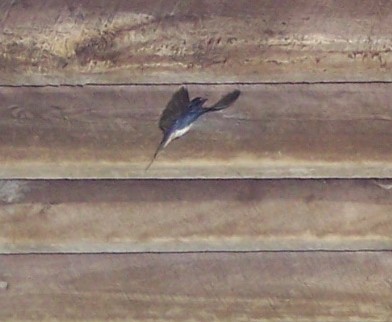
Once again, we were surprised by another lovely June morning (not
too hot, not too humid, and a light breeze). Our teams continue to
practice different selected skills each day. Today, we focused on two skills: shovel skimming and trowelling.
Shovel skimming, as opposed to simply "digging" with a shovel, requires
a relatively precise use of the shovel blade to remove a thin slice of
earth. Properly done, this leaves a clean fresh-cut surface in which
soil stains can readily be seen. Below, Barrett practices this new
technique. We can often remove the plowzone rapidly with the shovel -- evidence
of postholes, pits, and other prehistoric cultural features have
already been "homogenized" in this zone by years of churning, turning,
and mixing by the plow. However, as we proceed beneath the plowzone
into more intact soil layers, we have to proceed slowly and cautiously
so that we don't destroy something before we know that it's there. Down
at the other end of our slowly emerging trench, Ryan and Erica are
honing their skimming skills as well. Somewhat later, Ryan discovered this recently deceased shrew in the
grass. While resembling a mouse or vole in some ways, this little
fellow is actually a rather agressive insectivore (certainly not as
timid as a mouse!). While it may have accidentally been trampled as we
uncovered our excavation units earlier in the day, shrews are often
frequently killed by other predators (cats and the like) because of
their resemblance to more familiar rodents. Once killed, their bodies
are often abandoned uneaten -- shrews have a very strong musky scent
gland that makes them unpalatable. Also during the day, students were practicing their trowelling
skills. The trowel is probably one of the most recognized
"archaeological tools" by the general public. Knowing when to use a
shovel and when to use a trowel is a skill that takes time to learn.
For final examination and photography of an excavation level, the
careful removal of a very thin layer of soil with a trowel across the
entire unit provides a clean and professional looking surface. Below,
Katie illustrates that she has mastered this technique (along with her
teammates!) with a nicely flat, clean unit. While examining the freshly cut hay next to our excavation area, we
also discovered an abanonded nest left by some of our local red-wing
blackbird couples. On Saturday, we will be working with volunteers from the general
public -- giving them a chance to try their hand at archaeology.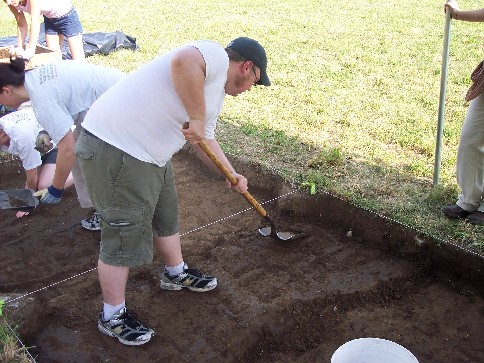

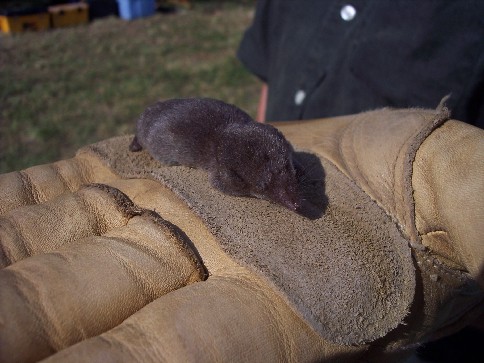

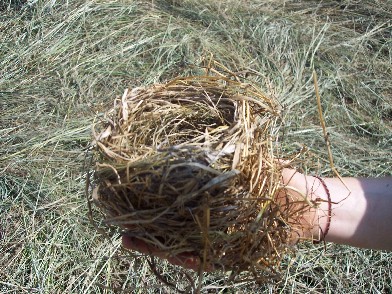
During each of our MTSU field school courses, we offer the
opportunity for interested volunteers to participate in our project as
the public outreach and community service aspect. Today was our first
"Volunteer Day" for 2006. Seven students gave up their Saturday to work
with these volunteers -- and in many instances to learn from them as
well. While some of our volunteers were trying their hand at
archaeology for the first time, most have been volunteers on many
professional archaeological projects across the United States (and the
world in some cases!). Volunteers today included a number of membgers
of the Middle Cumberland Archaeological Society -- an organization that
has been a partner with MTSU for many years now. Our thanks to our volunteers today: Georgia Dennis, Ellis Durham,
Elaine Hackerman, Paul and Dahlia Newton, and Judy Shook. With the help of highly experienced volunteers and dedicated
students, we made some substantial progress today. Below, Ellis Durham
-- one of our most skilled and dedicated volunteers -- works with
student Alex Bird to clean up one of our western excavation units.
Ellis has volunteered on just about every MTSU field school since
1995. In this area, as we excavated down into Level 5 (40-50 cm below the
current ground surface) we discovered some very intriguing linear soil
stains that could turn out to be the narrow trenches excavated for wall
trench houses. In the photo below, one of these linear soil stains is
shown during the process of cleanup. As the day proceeded, these soil stains became a bit more clearly
defined, but many of them still remain difficult to interpret in the
tiny "window" that we've opened up into this site. Archaeology is in
some ways like working a jigsaw puzzle -- but in our case, we have to
find enough of the pieces before we can start putting them together.
And, unfortunately, we don't have the picture on the box top to help us
along! At the close of the day, however, we are optimistic that we MAY
have discovered part of the ditch for the palisade surrounding this
ancient town. While we'll have to investigate this further next week
and the weeks afterward to confirm our suspicions, the stain outlined
in the photograph below holds strong promise. It seems to line up with
a similar segment of trench discovered about 20 meters to our south
when the waterline was replaced along US 25 in 2004. Thanks to the
records of the archaeologists who conducted that project, we are able
to match up our discovery with what they found almost two years
ago. To the east, we closed out two of our excavation units -- having
reached undisturbed "subsoil" without any signs of postholes, pits, or
other cultural features. These two crews will move several meters to
the north on Monday to open new excavation units. In the other two eastern excavation units, however, we hit some
promising features. Below, volunteers Georgia Dennis and Judy Shook
work with Beth and Brandy. The photograph below shows a small linear concentration of charred
wood named with the unprepossing title of "Feature 3." When we
identify interesting stains or concentration such as this one, we
assign them numbers and then sketch them and photograph them before
excavating them further. Unfortunately, this concentration turned out to be a rodent burrow
filled with charcoal. Fortunately, however, it was a clue to what
turned up beneath it -- a large posthole filled with charred wood
(possibly a post burned in place -- although we'll have to wait until
next week to confirm that). The mouse or other rodent had burrowed
through the posthole and the charred wood had later filled up the
burrow that was just barely on top of the posthole. In these two units, we'll continue excavation looking for other
postholes and features that might be related to this recent discovery.
But that will have to wait until next week. The crew and project staff
are taking a well deserved break on Sunday! Check back with us next
week!
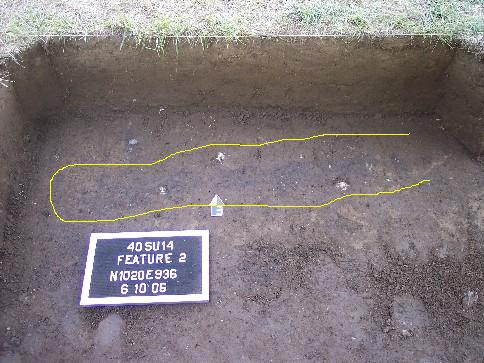

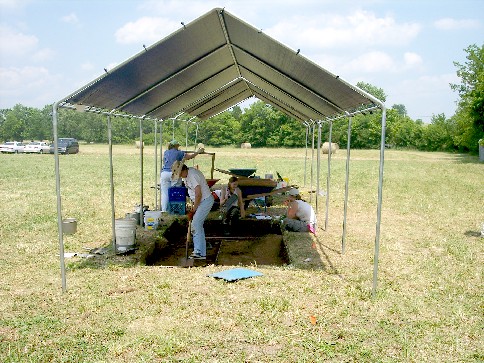
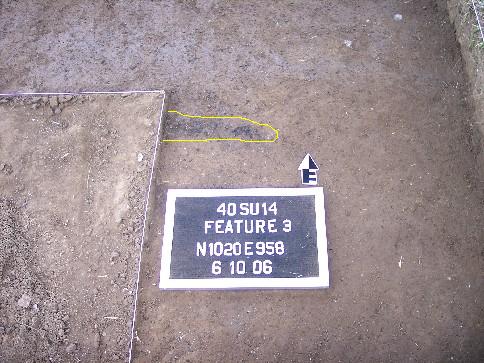
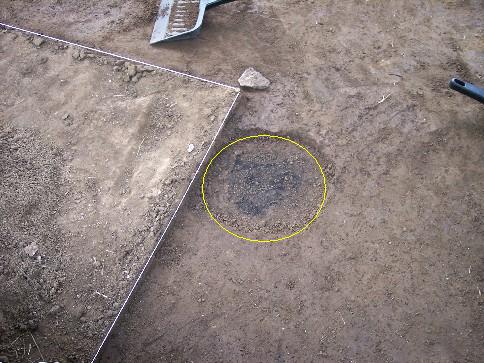
With hopes that noticing it doesn't "jinx" our good luck thus far --
the weather has been very cooperative with our project during the first
several days. Today was slightly overcast, not too humid, not too hot,
and just about perfect for "digging." As we take off the plastic covering our excavation areas each morning,
we do a quick inspection to make sure that we don't have any uninvited
guests who moved in during the previous night. In the past, I've found
everything from five-foot long snakes to a snoozing skunk to black widow
spiders. Thus far, we've had nothing more startling than a few crickets
-- and a few dozen teeny-tiney spiders. The one below is about half the
size of the end of a pencil eraser -- and is carrying a mass of babies on
the back. Today, we closed out two of our excavation units -- having reached the
undisturbed clay subsoil beneath the plowzone with no signs of features.
When "closing out" excavation units, we carefully record the "profiles" or
"side view" of the walls of the excavation units. These records are our
interpretation of the layers of soil that we have excavated through.
Below, Meagan, Bekah, and Jesse are drawing the south wall of their
excavation. Directly east of them, Richard and Natalie are drawing their south
profile, while Brandy prepares the north wall. In our westernmost units, the complex set of features uncovered on
Saturday caused us to pause and do a similar, but slight different kind of
recording -- a "plan view" or drawing of the bottom of the excavation.
Below, Katie, RObin and Lacey are discussing strategies for their
recording tasks while Erica and Ryan do the same in the background. Meanwhile, Ms. Beahm (Field Assistant) and I laid out four new
excavation units about 20 meters to the north. Below, Emily and I are
using a bit of basic geometry to triangulate the locations of these
areas. As an example of the slow and careful process that we use to record our
progress in sensitive excavation areas, the photographs below show the
same excavation unit at about 11:00 am and 4:00 pm (the rock in the yellow
circle is the same rock). The first photo shows a few scattered limestone
rocks and some hints of soil stains -- the second photo shows the same
area a little more than an inch deeper. In that photo, we have begun to
expose the top of a relatively dense midden deposit containing numerous
limestone fragments, broken pieces of Native American pottery, and an even
more complex set of features. It will take us most of tomorrow -- and
maybe Wednesday -- to sort out what happened in this area about 1000 years
ago. While on a trip to pick up some more lumber to serve as weights for our
plastic, we caught two wild turkeys "grazing" just over the crest of the
ridge from where we're excavating. Turkey season is over -- and they know
it! As we excavate beneath the plowzone, a number of interesting artifacts
begin to show up -- not particularly valuable for their dollar value, but
valuable because of what they can tell us about the daily lives of the
native peoples who lived here ten centuries ago. Below, a handle for a
tool is shown in place -- it is made from a deer antler tine. Note the
similarity in size between the handle of the trowel and the antler
handle. We also discovered a broken and discarded "celt" -- a term that we use
for a woodworking tool similar to an axe. The axe is heavily polished,
worn, and broken -- but parts of the "bit" remain intact (indicated by the
arrows). As we progress into our second week on the project, we are beginning to
develop an understanding of the soils on the site, the different
distribution of artifacts and features in our small "window" into this
vast site, and will begin to move both faster and slower as the conditions
warrant. Keep checking back with us!
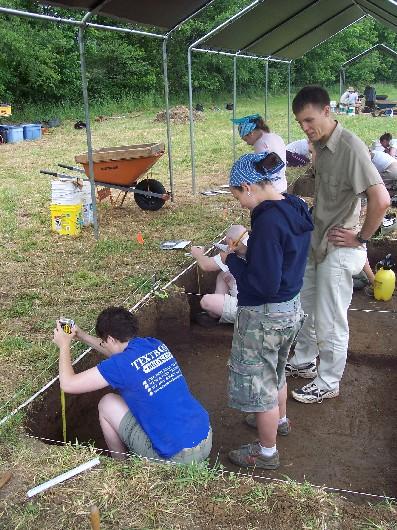
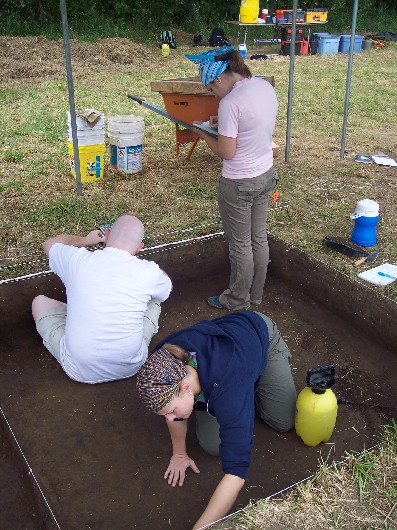

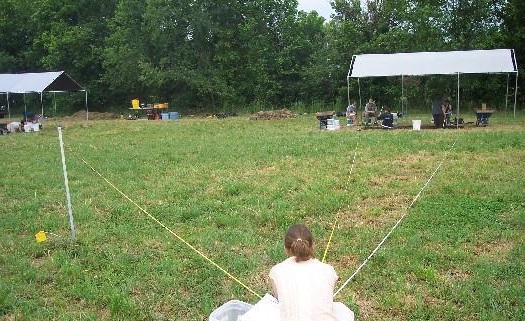
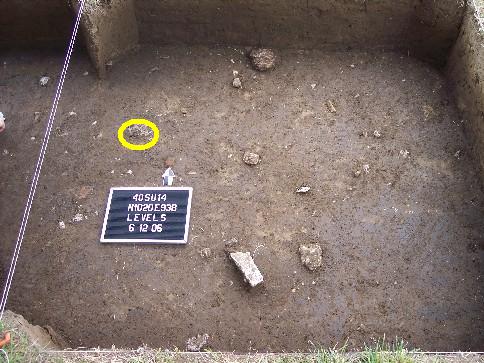

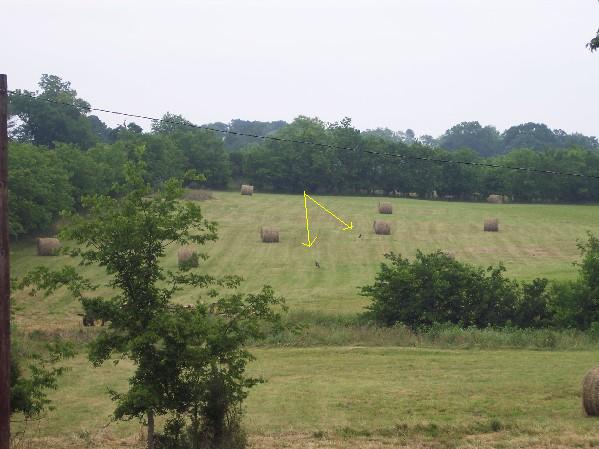
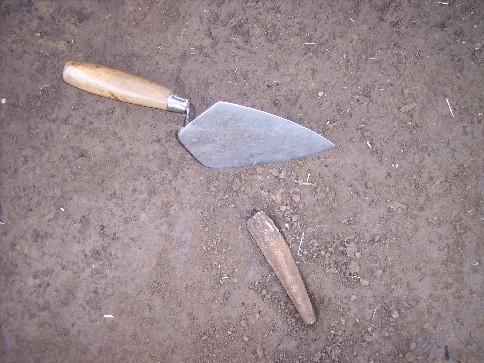
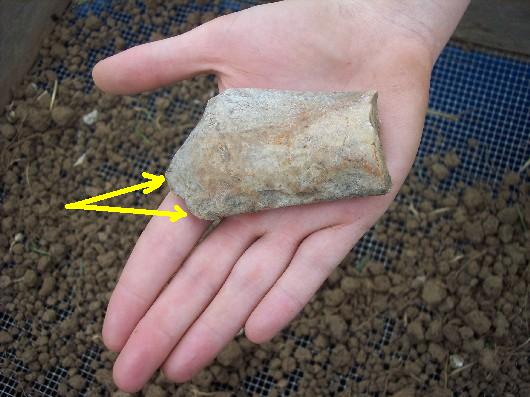
Another beautiful day for archaeology at Castalian Springs in June --
bright sunny day, but not too humid and a lovely breeze. When we arrive a
bit after 7:00 this morning, a majestic red-tailed hawk was perched atop
one of the haybales across the field from our excavations. He/she declined
to wait for me to get a closer-up photo -- so just take my word that the
speck below is a hawk! Fortunately or not, we don't have a lot of photos for today -- your
field correspondent was tied up actually having to do physical labor
today. While I prefer that the students get the opportunity to experience
the hard labor of fieldwork, sometimes I have to step in and try to figure
out what we're looking at before I can tell them how to proceed. Today
was one of those days. In our westernmost units, we began excavations into that complex set of
features described yesterday. While we didn't have an answer at the end
of the day on exactly WHAT we're finding -- we have moved into areas that
are largely undisturbed by the plow and have some spectacular information
for the archaeologist. We are now discovering large fragments of broken
pottery discarded almost 1000 years ago by native peoples. The
photograph below shows on of these pieces in situ -- or, "as we
found it in the ground. As the day proceeded, we excavated several hundreds of fragments
of pottery, stone tools, and animal remains -- two beautiful
fragments of a jar and plate are shown below. Elsewhere on the site, our other four student teams opened new
excavation areas today -- and made some great progress. Sometime
tomorrow, I expect all of them will be discovering some additional
new and exciting information about this ancient native town. Our dedicated and exceptionally hard-working student teams have moved a
giant amount of dirt in the past week. Our progress in just one week has
been stellar -- and entirely due to their excitement, interest, and true
dedication to the goals of our shared project. I couldn't ask for a
better bunch of team members. As the photo below indicates, our screened
dirt has become a noticeable feature on the landscape in its own
right. We also had some able assistance from Dr. Hugh Berryman -- forensic
anthropologist at MTSU -- who volunteered this afternoon. And, we want to acknowledge the able-bodied help from a recent
graduate of our program at MTSU -- Mike Warren. An "alum" of the
Castalian Springs project from last year, Mike has been out several
days to lend his labor to the project in general and to share his
experiences with the new students on this long term project.

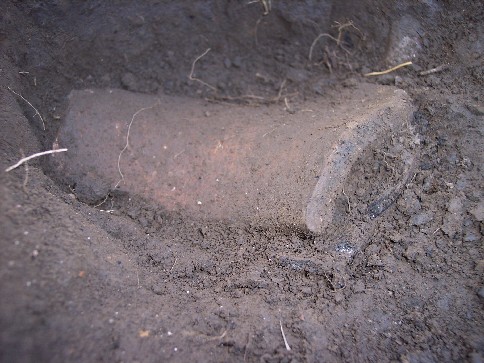
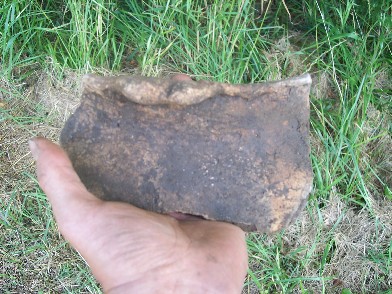

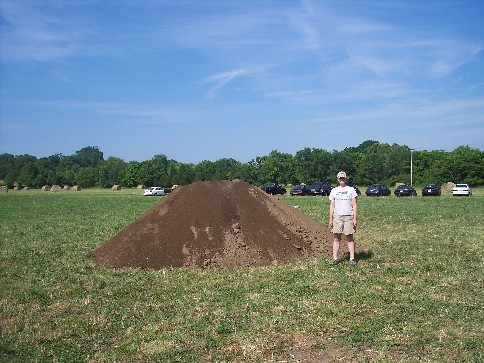

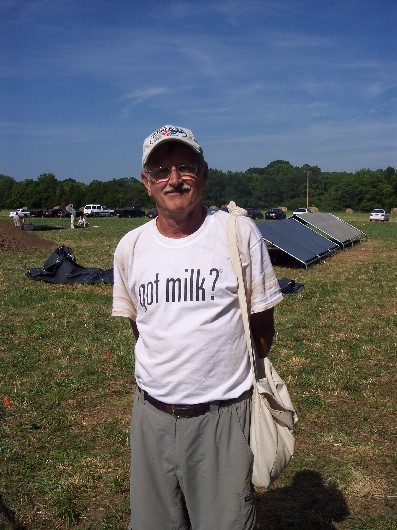
I'm pleased to note that we had yet another beautiful day to be
outdoors in Castalian Springs. Our red-tailed hawk friend was once
again perched on a haybale when we arrived. We took a brief trip up to the hilltop overlooking the site to get some
semi-aerial photographs of our excavations. The green expanse is the area
where we're working this year -- you can see most of our excavations
covered with plastic near the treeline in the distance. On the circuitous drive through the fields to get to the hilltop, we
passed our "tom turkey" from day before yesterday and a beautiful doe --
neither of them waited for me to get my camera ready before darting into
the high grass and trees. Both are a reminder, however, of the tremendous
value of this 132-acres not only for archaeology -- but also for the
wildlife that will find refuge here as houses and subdivisions spring up
seemingly overnight along US 25. In our westernmost units, we continued to investigate the series of
features discovered last week. The "feature" is a very large apparently
square or rectangular pit excavated by the native inhabitants of this town
hundreds of years ago. Although we haven't fully exposed the feature yet,
it appears to be about 4.5 meters east-west (about 14 feet) and possibly
around the same north-south. The photograph below shows an exploratory
excavation into the feature. The yellow line running from left to right
is the top of feature in our excavations. The yellow arrows show where
the feature extends into other excavation units. The blue line to the
right of the photograph is the edge of the feature -- hard clay
subsoil. Later in the day, we continued excavations in this exploratory
cross-section -- revealing the bottom of the feature. It has been fairly
heavily burned (the yellow arrows point to the exposed orange-red fired
bottom of the pit). This may well prove to be a spectacular discovery as
the next few days proceed. To the north and east, some of our new excavation areas produced some
truly intriguing sets of features -- a giant set of postholes, trenches,
and other features that we will be investigating over the next couple of
days. The photograph below shows one of these units -- the yellow lines
outline an extremely well defined trench -- this is either a segment of
the palisade line that we've been searching for or a very wide wall trench
for a house occupied by prehistoric peoples almost one thousand years ago.
The areas outlined in blue appear to be part of a house wall -- probably a
wall trench house. The segment at the bottom of the photograph appears to
be a wall trench -- while the upper circles are postholes. While
preliminary, I suspect that the wall trench has been partially destroyed
by plowing -- a bit of it is preserved, but elsewhere only the postholes
in the bottom of the trench remain. The white circles are another series
of postholes probably representing part of a house wall. On large native
towns occupied for several centuries, we often find that houses have been
built and then rebuilt on the same location one or more times. The
pattern of posts that formed the walls can sometimes be difficult to sort
out -- but in this case, it looks fairly clearcut. We'll be expanding our
excavations in this area to see if we can identify all of the walls for
this house (and its multiple rebuildings) along with checking to see if
our trench MIGHT be the palisade line. Directly to the east of the excavation above -- but about ten cm higher
(about 4 inches) -- the crew has already identified some probable features
related to the house. The yellow circles are possible postholes -- the
large size of two of these suggests they may be interior support posts for
the house (which are usually two-three times as large as the wall posts).
The area outlined in blue is the top of a larger feature that is "harder"
and contains flecks of charcoal and pieces of burned clay. This is in a
good place to be the hearth or "fire pit" in the center of the house. We
will continue our investigations here as well on Thursday. Only three and half more weeks to go on our project this summer -- we
have already discovered that this ancient native town has many secrets
preserved beneath the plowzone. We will uncover many important bits of
information over the next few days and weeks -- thanks to the hard work of
the students. We will also set the stage for future projects in the coming
summers. Finally, I will mention our appreciation for the many dozens of
visitors that we've had to our project over the past week and a half -- we
appreciate both the interest expressed by the citizens of Castalian
Springs and the information they've shared about the property on which
we're working and their lives in this community.
Keep checking back -- we will be reporting new discoveries every day in
the field now!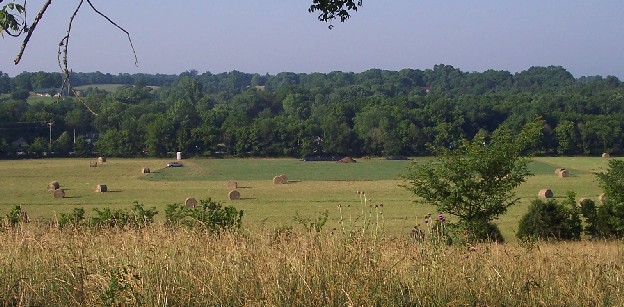
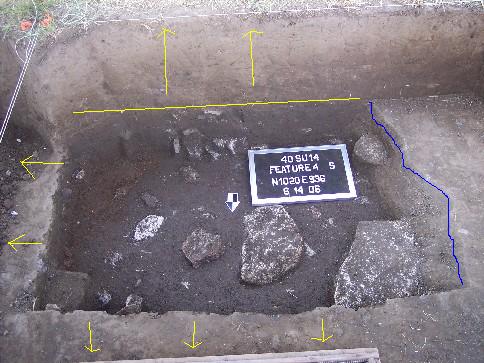
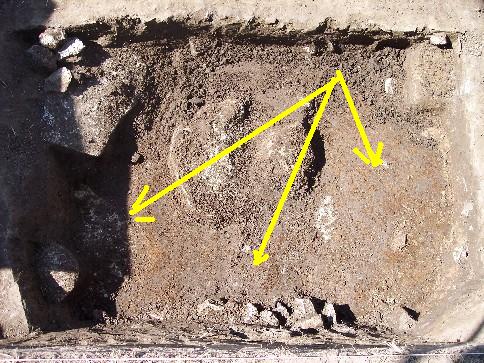
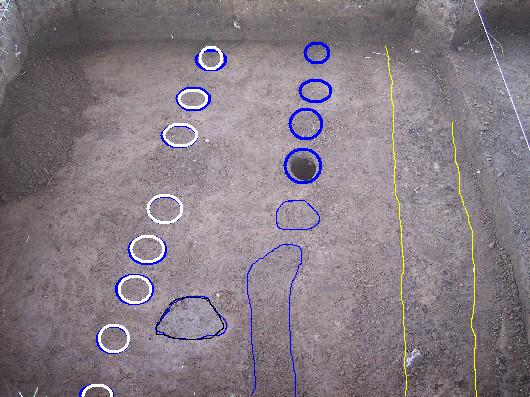
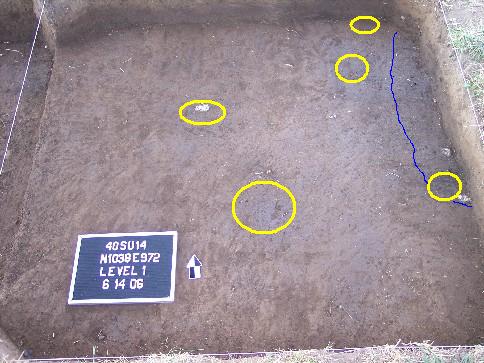
Our day started once again with a beautiful morning. While still a
wonderful day for fieldwork -- both the heat and the humidity picked up
enough in the afternoon to be noticeable. Probably a taste of things to
come. We didn't see our hawk friend this morning, but another doe was
sighted on the back side of the property. When we uncovered our excavations this morning, we discovered a couple
of guests -- a field mouse (who escaped into his burrow in the field
before I could snap a photo) and a shrew (trapped in one of the deeper
excavations). Unlike our friend from June 9,
this one was captured in a bucket and released in the field. In our northeastern units, we continued investigations of the possible
palisade trench and house patterns today. Our interpretations have
changed a bit as we investigated these areas further. Yesterday, one of
our excavations looked like this: Today, further investigations yielded a more refined picture. The
features outlined in black are possible postholes that don't yet seem to
fit into a pattern. Those outlined in white appear to be a series of
posts for a house wall that turns to the east. Those outlined in blue are
a series of possible postholes for a wall probably associated with a
second house. The trench outlined in yellow is our possible palisade
trench. Directly to the east, our further investigations revealed some
additional features and refined our understanding of some from
yesterday. Yesterday, our interpretation looked like this:
Today, we examined these further. The stain outlined in yellow
turned out to be a shallow irregular shaped pit -- not much we
could tell from it. The area outlined in blue remains a possible
hearth -- we'll excavate it on Friday and see how that turns out.
The smaller circles outlined in white appear to be a line of wall
posts that match up with the other wall shown in the photos
above. As always, investigating these features is slow and painstaking
work -- we stop to make records, drawings, and photographs at each
step in the process. Below, Bekah, Jesse, and Meagan are mapping a
recently excavated feature in their excavation unit. In order to examine the possible palisade trench, we had to open
another unit to the south to see how far the trench extended.
Below, Richard and Brandy are doing hard labor in the afternoon
heat to see if the trench continues. While their crewmate Natalie makes the "wheelbarrow run" up the
rapidly growing backdirt pile... During the day, I excavated a 50-cm long section of the palisade
trench to see what it looked like. It is an exceptionally
well-defined and deep trench that certainly appears to be something
more than a wall-trench for a house. By the end of the day,
Richard, Brandy and Natalie had already revealed the top of the
trench continuing another two meters to the south. On Friday,
we'll continue investigations on this feature. Elsewhere on the site, we continued investigating the large pit feature
in our western units. With some massive efforts by the students and a
volunteer (Robin, Lacey, Katie, Erica, Ryan, Alex and Georgia) we managed
to get two new excavation units down to reveal the top of this feature.
It now appears to be a large probably circular pit -- in the photo below,
the yellow line shows our current "outline" of that feature. In the
exploratory excavation -- note that we've cleaned it up and the red-orange
burned soil at the base extends across the entire bottom of that
exploration. From a different angle, the yellow shows the outline of the
large circular pit -- the blue shows another pit feature showing up
at the lower right. Figuring this one out -- and excavating it --
will take another several days. More news on Friday.






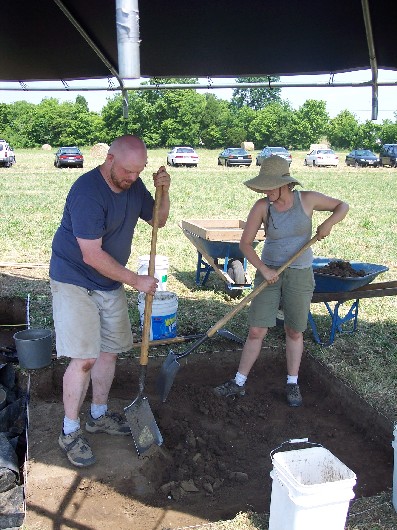
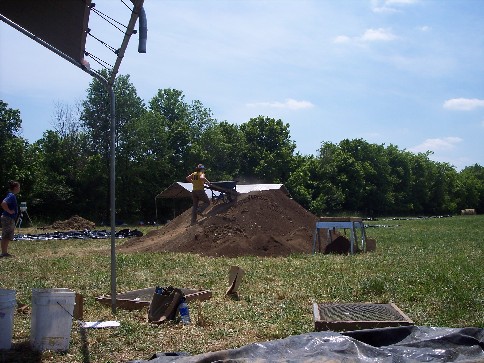
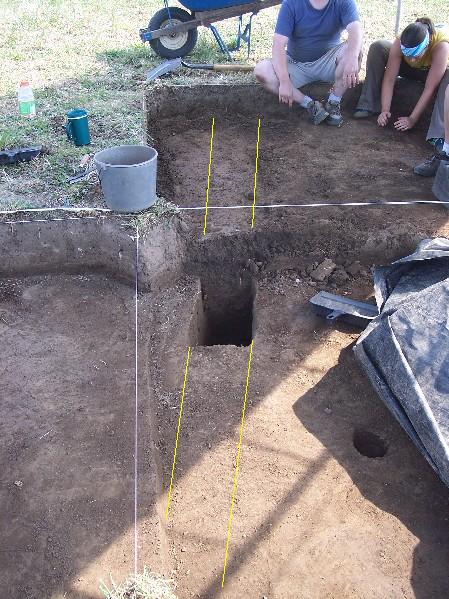
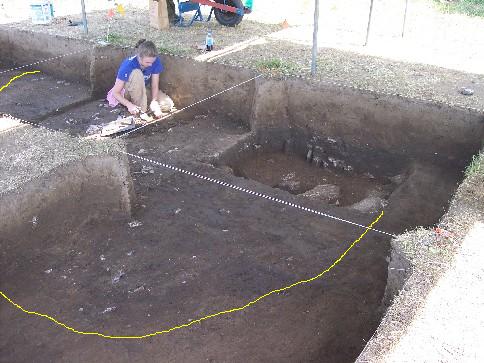
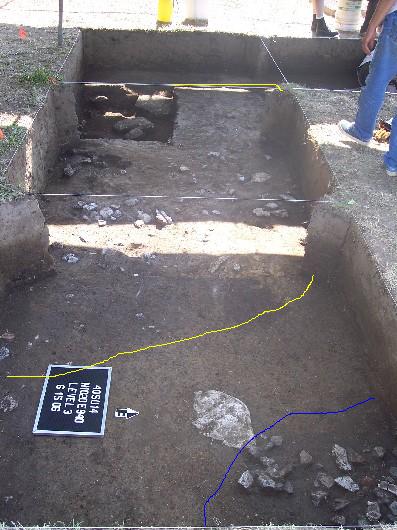
Another great day to be outdoors in Sumner County -- the heat and
humidity have both picked up a bit, but not to the point (yet!) that it is
a burden. I spent a bit of time early this morning trying to persuade some
goldfinches to come close enough for a decent photograph -- no luck there.
Three of our raven or crow friends were in the field next to our work
area, though, and one of them agreed to pose briefly for a photo atop a
hay bale. Each night, various colonies of ants build their homes beneath our
plastic. Usually, these are the familiar "anthills," but this morning one
of these colonies left us a curiously question-mark (?) shaped hill -- we
have lots of questions left to answer. But, probably, their question was
more like -- "Why the heck do you people dig us up every day?" Mid-morning, Drs. Tanya Peres (one of our project research faculty) and
Jackie Eller from MTSU dropped by to inspect our progress. In our westernmost excavation areas, we continued our exploration of
"Feature 4" -- the large (apparently) circular pit and possible structure.
Although much of the day was taken up with taking notes and making
drawings, we began excavation of the "midden" filling several sections of
this feature today. Below, Ryan and Erica begin excavation of the rounded
corner in their unit. As we expected, this ancient garbage deposit is filled with interesting
artifacts of "daily life" used and discarded by the people who lived at
Castalian Springs a millenium ago. A fragment of deer antler -- most of
the larger tines have probably been used as tools. Many large and small fragments of pottery -- including this large rim
portion of a storage jar. And, intriguingly, we are retrieving numerous fragments of fabric
impressed pans. The "decoration" on the fragment is the impression of
fabric or textiles on the "bottom" of the pan. Just as we sometimes use
discarded clothes and other fabrics as rags after they outlive their
primary purpose, ancient Mississippian peoples used their discarded
fabrics to line the molds for these pans. They could then use the fabrics
to lift the pan from the mold. Since the clothes and other textiles
created by these peoples rarely survive over the centuries, these
impressions in ceramic are often our only way to reconstruct the multitude
of everyday and fancy fabrics they created. At Castalian Springs, many of
these pans may have been used to evaporate the mineral waters from the
springs to produce salt and medicines. We recovered a number of these pans last year across the highway in our
digs (see the entry for June 17, 2005 for
example). Similar to last year, we are also recovering fragments of a special
kind of flint or chert. The fragment of flint or chert shown below is a
very special kind of stone available only on the western course of the
Cumberland River in Stewart COunty and along the Tennessee River. Called
"Dover Flint" -- this highly prized material was traded throughout the
eastern United States. This fragment made its way to Castalian Springs
from Dover, Tennessee or thereabouts. On Saturday and through the next week or so, we'll continue
investigating this feature and its contents. In
our northeastern units, we continued investigations of the possible
palisade trench and house patterns today. In the photograph
below, Georgia Dennis captured me instructing several students on
how to excavate the feature we thought might be a hearth or
fireplace. It now appears to be more likely a pit feature filled with
garbage, but still interesting. Our crews also completed exposing the feature that we believe to be the
palisade trench -- in the photograph below, I've included yellow arrows
showing the edges of the trench, but have left the points between for your
evaluation. The trench is very clearly evident running from left to right
in the photo. We'll be opening several new excavation units on Saturday
to see if we can follow this feature a few meters further to the north and
south. Two of our crews have worked super-hard in four excavation units so far
-- and found little or nothing for their labors. Nonetheless -- their
efforts have provided important information for our overall team effort.
Where things are "not" is just as important in developing our
understanding of this ancient town as where things "are." Small
consolation in the absence of the "thrill of discovery" -- but Barrett,
Jonathan, Beth, Jennifer, Tracy, and Lynne have maintained good spirits
throughout. Maybe in the next pit... Below, Lynne, Tracy, and Jennifer
lay out some new excavation units for Saturday. Excavations will continue on Saturday with help from a number of
volunteers. Check back and see what we find!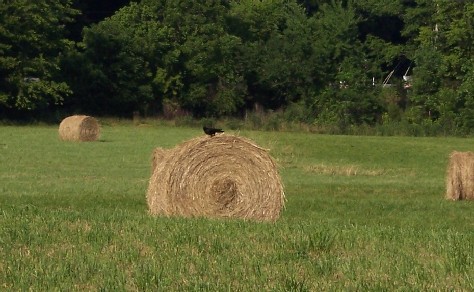


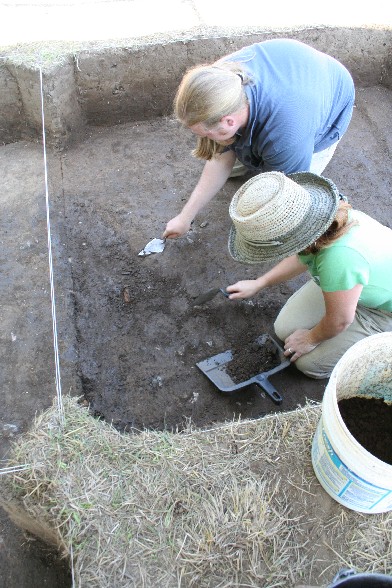
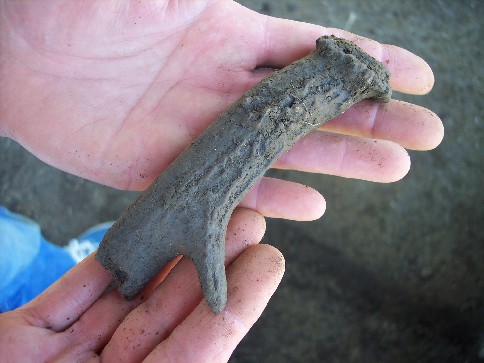
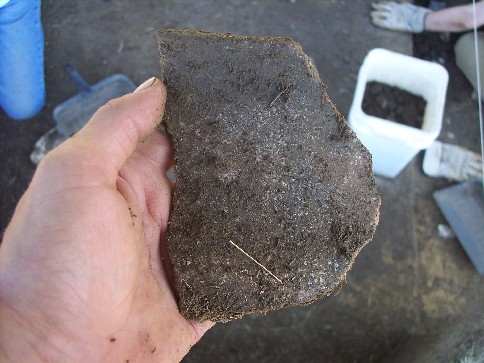

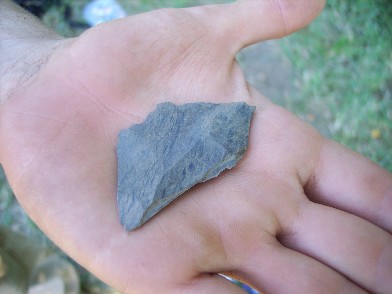
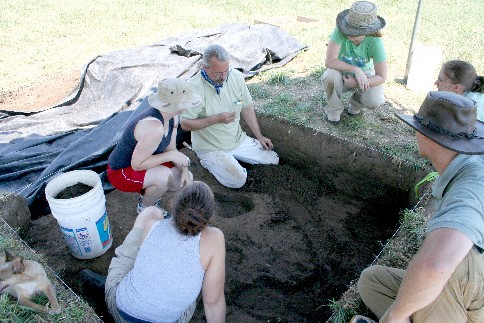
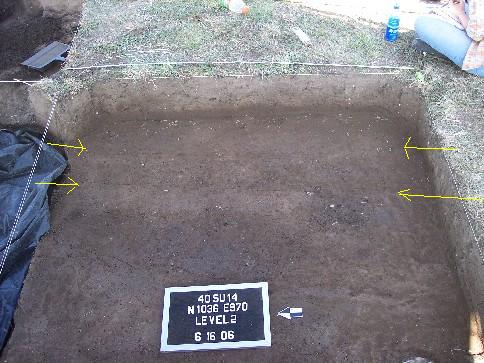
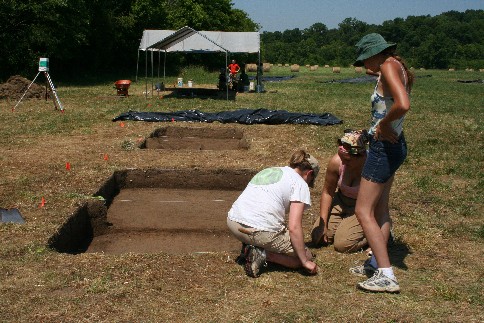
With the exception of the heat and the humidity, we had a great day on
the dig today (the breeze helped out a lot!). But, I think I'm safe to
say that all of us created a bit more "sweat equity" in the project than
on previous days. Today was another of our "public outreach days" -- where we invite
interested community members to try their hand at "real archaeology."
Several of the students in the class show up each weekend to work with
community volunteers. Our thanks to the volunteers who took advantage of the chance to work
on this project today: Lindsey Bowman, Howie Brainerd, Betty Callis, Edie
Crane, Georgia Dennis, Ellis Durham, Ann and Matt Funkhouser, Elaine
Hackerman, George Heinrich, Caroline Kiev, Robert Miller, Mary Saums, Judy
Shook, Catherine and Elizabeth Stewart, Jennie Walker, and Mike Warren.
Georgia and Mike are both alums of our archaeology program and frequently
share their expertise (and labor) with current students. Other volunteers
include individuals from the Middle Cumberland Archaeological Society --
many of whom have participated in archaeological projects across the
country (and world). Several of today's volunteers have participated in
many of our MTSU field projects over the past ten years plus. We worked on several different areas today with the help of volunteers.
One of our primary goals is to open some new excavation units to see if we
can hit the trench for the town wall at some more distant locations.
Sixteen meters to the south of our known trench, we opened two new units
that will hopefully reveal evidence of the continuing town wall. At the screen below, Lynne works with volunteers Elaine and her mother
and brother while Tracy shovels at the right. While in the next unit, Richard and Natalie work with volunteers George
and Mary in the search for another section of the palisade trench. To the north, Jesse works with volunteers Caroline and Edie
investigating Feature 9. We also expanded our investigations of Feature 4 -- the large circular
(?) pit/structure in our western excavation areas. Below, Brandy works
with volunteers Katherine and Elizabeth while in the background, Howie,
Ellis, and Alex work on the same feature in their units. Here, Ellis and Beth are carefully exposing fragments of limestone,
pottery, and animal bone in the pit fill. By the close of the day, we had made some substantial progress in
completing the first level in the feature. On Monday, we'll complete the
10-cm level and map the exposed artifacts before proceeding with a second
level. The garbage filling the pit continues to include a fascinating
collection of broken pottery -- including more of the fabric impressed
pottery. The crew is resting up after a second hard week in the field
-- excavations will resume on Monday morning bright and
early.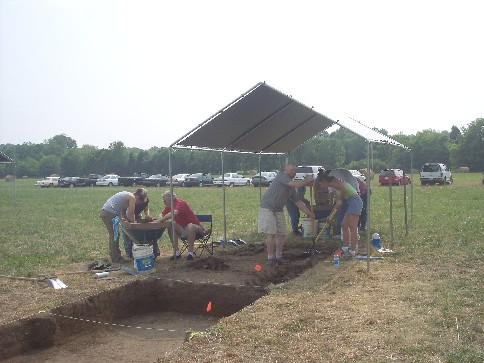
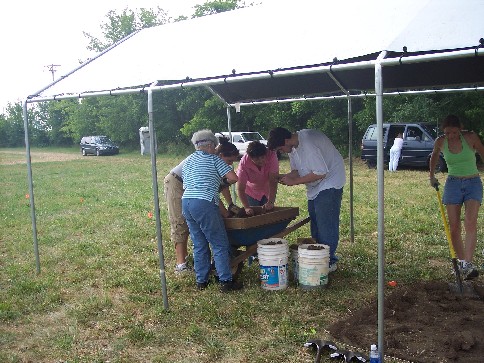

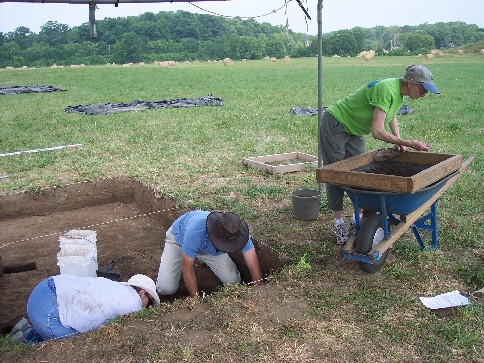
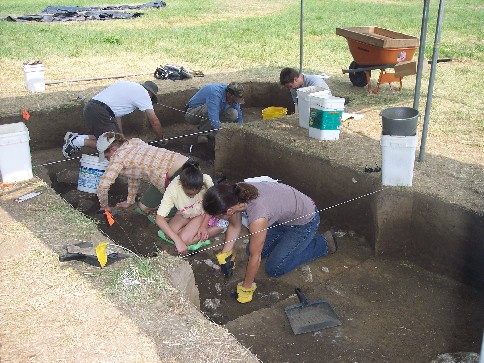
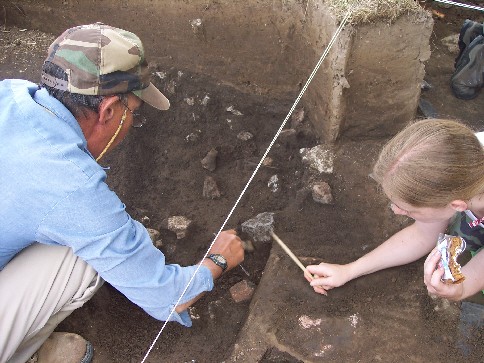



While the day was not too hot and overcast, it was a bit wet and muggy
after the rain last evening. The day began with bailing the water from
our plastic. Unfortunately, some pinhole leaks in the plastic covering some of our
excavations left them too soaked to work on today. We carefully bailed
water with buckets and sponges and let the units dry for today. While
problematic for us, the frog below was clearly thrilled with the new
"ponds" we created. We worked on finishing excavations in several areas -- mostly
excavating plowzone in some new excavation units that have revealed little
to us yet. We cleaned up the section of palisade trench for photographs
-- in the photo below, the fill in the trench shows very nicely. We also began excavating the two-meter long section of the trench in
one of the units -- unfortunately, the lower half of the fill in the
trench was soaked with water apparently seeping along the length of the
buried ditch. The fill in the trench continues to yield a few sparse Mississippian
period artifacts -- fragments of pottery, animal bone, and an occasional
interesting artifact like the "nutting stone" shown below. The stone has
a small hickory nut sized pit on each side -- generally, these are
interpreted as tool for breaking open hickory nuts and/or walnuts. We also completed excavations down to the bottom of the plowzone in two
units where we were hoping to find a continuation of the palisade ditch.
Instead of the straightforward trenchline we were hoping for, we seem to
have discovered a section of trench or ditch turning at several right
angles (outlined below in yellow). We're still cleaning and interpreting
the top of this feature, so it will be another day or so before we have a
better picture of this feature. However, it seems at least possible that we have discovered one of the
"bastions" or towers that are frequently found on town palisades of this
era. The map shown below is from the Rutherford-Kizer Mounds near
Hendersonville (about 17 miles west of our site). During the early 1990s,
our excavations at the site included investigations of a long segment of
palisade trench similar to the one at Castalian Springs. Along that
segment, we excavated two of these bastions -- the arrow on the map points
to one of these bastions. What we found today MIGHT be something similar
to this feature at Rutherford-Kizer -- only time and a bit more excavation
will tell. Hopefully, the weather will cooperate over the next few days and we'll
be able to continue investigations of these features. Your web reporter
has an evening lecture to attend in Nashville on Tuesday night after our
day in the field, so the web pages for Tuesday may not be posted until
Wednesday evening!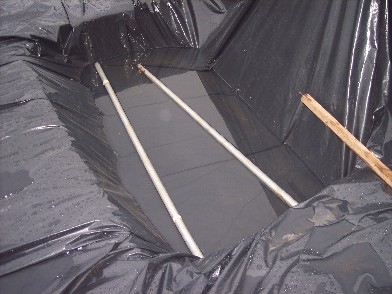
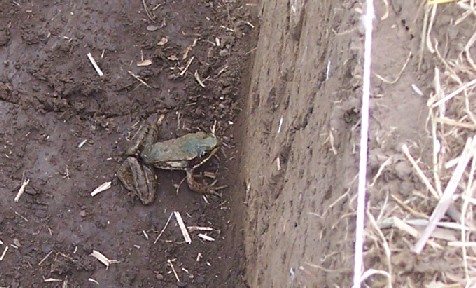
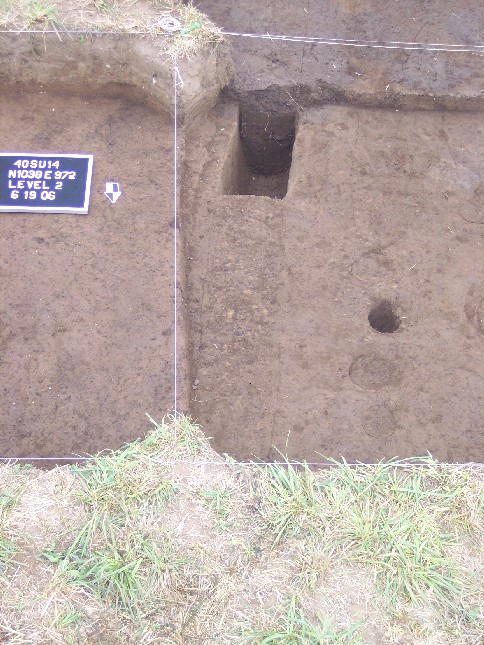

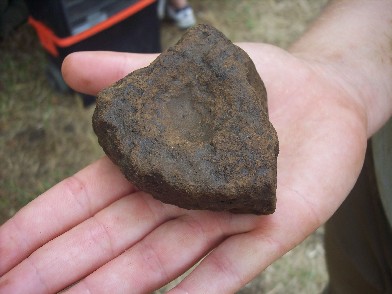
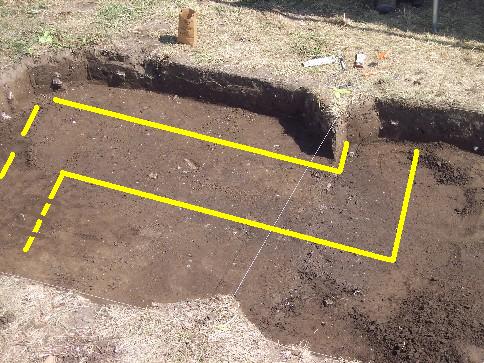

Our early morning arrival at the Castalian Springs site was greeted by
a lovely fog creating a view of "Mounds in the Mist." Our excavations are
visible at the left under our plastic -- with the main platform mound at
the right. The fog settling on the spiderwebs throughout the fields created a
landscape filled with nature's architecture -- the photo below shows only
one of the hundreds of amazing webs highlighted by the dew, fog, and early
morning sun. Unfortunately, while appreciating the mysterious vistas created by the
morning fog, I also know that a nice Tennessee fog in June is an excellent
indicator that your sweat glands will get a workout later. We continued work in several excavation areas in the morning. Jesse,
Meagan and Bekah opened a new unit to expose the rest of the deep and
enigmatic pit feature excavated on Saturday. Elsewhere, we completed excavations of a 2-meter long segment of the
trench for the town palisade. And, six meters to the north, we exposed what appears to be another
2-meter long segment of the palisade trench. While not very visible in
this photograph, the "in person" view of it was fairly convincing as we
closed up for today. We'll continue investigating it on Wednesday and
hopefully will have a fuller report then! We continued excavations in a couple of other units, but have nothing
to report from there yet -- elsewhere on the site, our "digs" were delayed
by waiting for the contents to dry from our leaks night before last. Having moved an enormous amount of dirt in the past couple of weeks
with good results, I decided we should take a little break from the field
excavations this afternoon (particularly given that the 90+ degree heat
was exceeded by the humidity level!). We packed up our tools at lunchtime... And moved over to our field laboratory after lunch to wash up some of
the thousands of artifacts recovered from our excavations of the last two
weeks. The photograph belows shows part of the artifacts from a single "lot"
or bag from our excavations. The artifacts includes dozens of fragments
of pottery, stone tools and manufacturing debris, animal bones discarded
from meals a thousand years ago -- and yes, a few rocks (well, they looked
like they might be something important when they were covered with dirt).
Our rule of thumb when excavating is -- "when in doubt, put it in the
bag!"
We adjourned from our labwork at 3:30 today -- many of the crewmembers
headed west to The Hermitage, Home of President Andrew Jackson to tour the
summer archaeological excavations there and to hear a lecture on the last
couple of years of excavations on the South Cabin. Mr. Daniel Brock, our
guide and speaker for the evening, is currently the Archaeologist
Supervisor at the Hermitage -- he is also an alum of our Castalian Springs
Archaeological Project at Bledsoe's Fort (from 2001) and a graduate of our
MTSU archaeology program. Our thanks to Dan for hosting our visit. Our digs resume on Wednesday morning with good promise for some new and
exciting discoveries -- the weather predictions this evening also offer a
good promise that our sweat glands will get some solid exercise. Check back tomorrow!
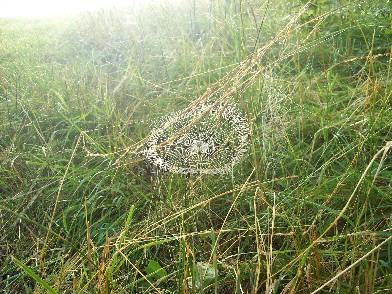
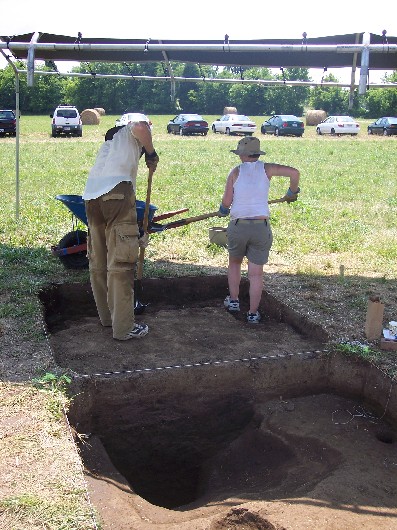
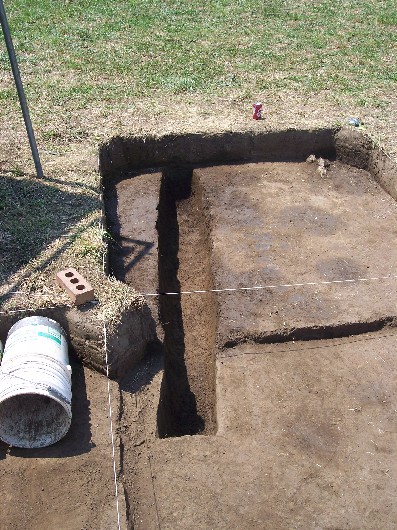
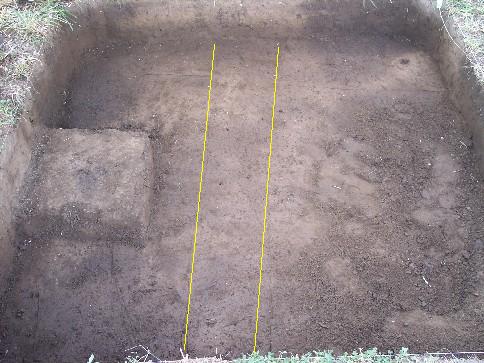
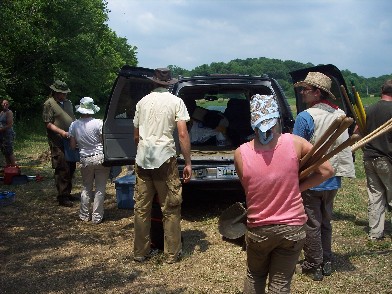


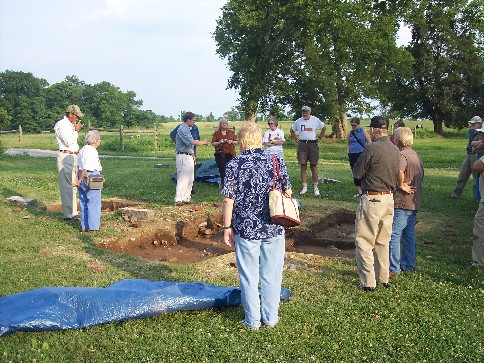
Each morning, I usually arrive early enough to spend about 20 minutes
exploring different parts of the 132-acre new state land acquisition at
Castalian Springs. Scattered on the rocky uplands and along the springfed
streams on the property are a number of chestnut oaks -- the one below has
suffered a lightning strike sometime in the past, but still makes a grand
picture against the early morning sky. Scattered throughout the high grass in locations too rough or rocky to
cut for hay, multitudes of milkweed plants like those shown below are
getting ready to bloom. The plants are named for their thick white sap --
a broken stem or leaf leaks the milky looking fluid. Milkweed serve as
the only host for the caterpillars of monarch butterflies. Monarchs lay
their eggs on the plants. The eggs then hatch into caterpillars, which
dine on the leaves of the host plant. The leaves are poisonous to many
animals (including humans). While the caterpillars are immune to the
toxins in the leaves, eating them makes the caterpillars and adult
monarchs poisonous to most predators. The dire predictions of rising temperature and humidity for today
proved to be precisely on target. Even the local buzzards declined to
circle over by late morning (the brief shade when they zoomed overhead
would have been refreshing!). Because of the heat index, we make good use
of our shelters (equipped with UV shielded tarps), and drink plenty of
water on frequent breaks as we work slowly but consistently. Bekah, Meagan, and Jesse completed removing the plowzone in the new
unit next to our deep posthole/or pit -- exposing the top of yet another
complex feature. As shown below, it does look as if the partially
excavated pit once contained a large post (circled in yellow) -- along
with a large scatter of burned clay. It now looks as if our first guesses
several days back were both right and wrong -- we originally interpreted
the "posthole" as a possible hearth. That was not quite on target, but it
did lead us to investigate further to the east and expand on our
information on this feature. A post of this size was probably the central
support post for the roof of a building -- perhaps matched with the lines
of small wall posts. The scattered of slightly plowed disturbed burned
clay will probably prove to be either the remnants of collapsed walls of
the structure -- or another "Possible Hearth." We've mapped and
photographed the initial exposure of these features today -- and will work
further to excavate them in the next day or two. We also continued investigations of other features next to the
"palisade trench." What we had originally interpreted as some rat burrows
running off the side of the palisade trench turned out to be rat burrows
(rodents love to burrow in and around walls and houses). Underneath those
rodent burrows, though, was a real feature created by the ancient
inhabitants of this town -- a narrow oblong trench parallel with the
"palisade trench." The upper "rodent runs" are shown below in yellow,
with the Native American feature outlined in blue. While we're not quite certain of the function of this short trench
today - it has yielded a number of pieces of mica, including the large
fragment shown below. This shiny mirrorlike substance was imported to
Castalian Springs from North Carolina -- usually this material was only
accessible to higher status or wealthier individuals and was used for
jewelry and adornments. Far to the west, our intrepid crew of Tracy, Jennifer, and Lynne
continued to tackle the beginnings of a short trench into the base of
Mound 1. We are hoping to determine if the current rise is actually a
"backdirt pile" from the 1890s excavations or the actual original location
of this mound. While we anticipate few artifacts from these
investigations, they are a critical part of figuring out how this town was
arranged and laid out. Our units back to the west that were soaked from the rain earlier this
week were finally dry enough to continue work on "Feature 4" -- the large
pit/structure. We completed excavating the upper half of the trash
deposit filling this feature -- the photograph below shows the multitude
of burned limestone fragments, pottery sherds, and animal bones. In the edited photograph below, the current outline of this enormous
pit is shown in yellow. We'll continue our excavation here on Thursday
and Friday. In the afternoon, we also began our practice of rotating two of our six
student crews into the lab each day under the supervision of a crew chief.
This practice not only transforms our artifacts from "lumps of dirty
stuff" into clean and analyzable objects, but also gives 1/3 of the team
an afternoon out of the heat to recoup. More news on Thursday -- promises to be another scorcher. 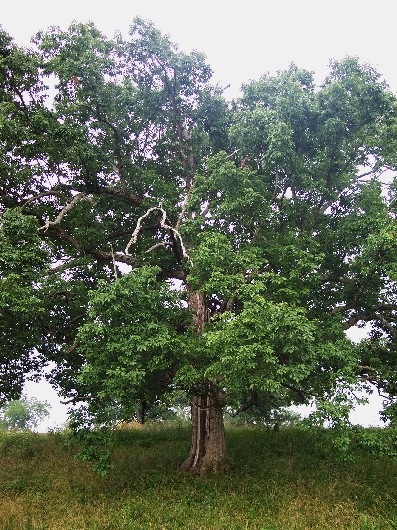
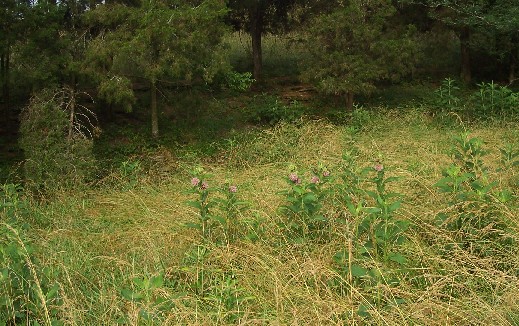

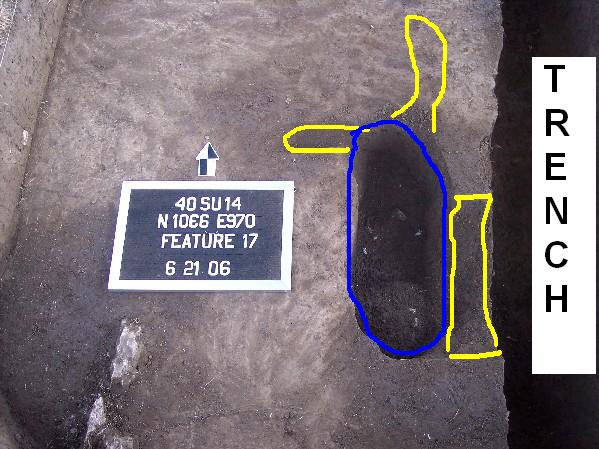
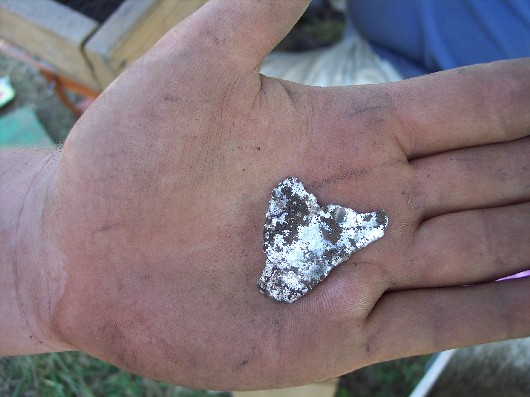

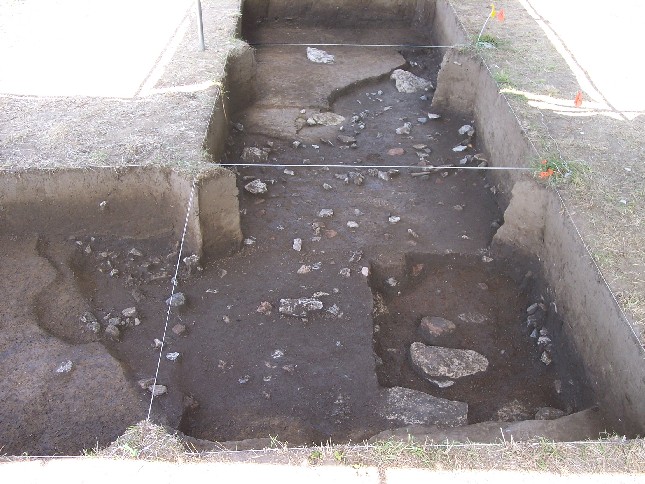
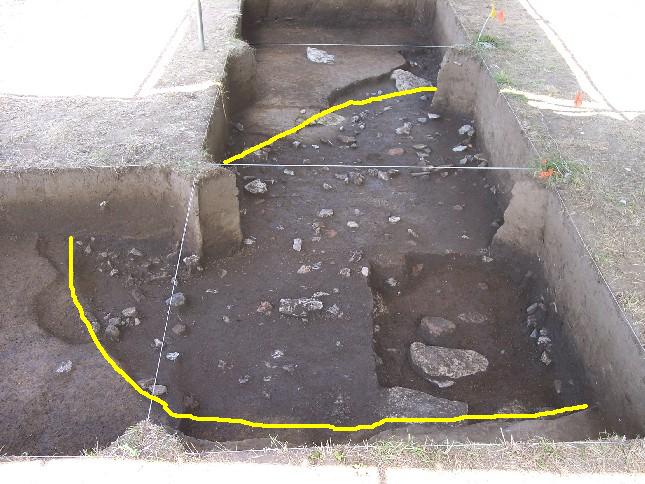
When I get out of my car at 7:30 in the morning and almost immediately
start to sweat without doing anything more than standing up, I don't need
Nostradamus to predict that the day is going to -- well -- "suck" for
archaeological labors. During our morning "team meeting," we reviewed our
safety protocols for working on days like today and prepared ourselves for
a slow workday with lots of water and rest-breaks (except of course, for
the two crews that were looking forward to their afternoon in our shady
lab washing artifacts!). With sensitive features under excavation in almost every unit scattered
across the field, I was kept busy today moving from unit to unit
monitoring progress, providing advice to students, and guzzling a couple
of gallons of water in between. When we opened our units this morning, we discovered that a pair of
"homesteaders" had claimed one of them... The pair of voles (aka meadow
mice, orchard mice, and field mice) had established an extensive set of
runways beneath the grass. We captured them and released them away from
the units. As we delve beneath the plowzone in various areas, we are finding many
hundreds of artifacts and features left by the native peoples of this
town. The photograph below shows a cluster of these artifacts --
everything from pottery sherds to remnants of meals to jewelry. Nothing
of much dollar value -- but of tremendous value to the archaeologist to
learn about the daily lives of the people who lived in Castalian Springs
way back when. We completed our excavations of Feature 17 today -- the short trench
segment that produced the mica. In the unit directly to the north, we
excavated another similar short trench segment -- and will start
excavating what appears to be a third one tomorrow (weather permitting!).
These features are somewhat enigmatic at this point (in other words -- I'm
not sure what they are!). But, in excavations at other nearby sites,
we've seen palisade walls that consisted of similar short trench segments.
This may be evidence of another version of the wall that surrounded the
town. Then again, it may be part of one of the houses/buildings that are
overlapping the long trench we believe to be the palisade wall. Give us
another week! To the north, Barrett and Jonathan worked in the blazing sun and
finally managed to clearly define another trench that we think will prove
to be a continuation of the palisade trench -- and probably part of a
bastion or tower. Back on the western side of our excavations, several crews continued
work on "Feature 4" - the large pit/structure. Below, Ryan works on
taking out "Level 2" -- removing the midden filling the feature down to
the burned orange/red surface. In a wider view, Ryan, Erica, Lacey, Katie and Georgia work on exposing
the very consistent burned surface at the bottom of Feature 4 in all four
units. We have laid out four additional units to expose the rest of this
feature -- excavations will start on those areas on Friday, Saturday, or
Monday -- depending on the weather! Two alums of last year's field school class at Castalian Springs showed
up today to assist. Below, Emily and Mike work on one of the units to see
if we can find another section of the palisade wall trench. In the mid-afternoon, some rumbles of thunder to our west and the
weather radio that I keep on site for safety purposes both announced that
some thunderstorms were possibly moving in our direction. Having spent
about 40 weeks of the last ten years standing in the fields of Castalian
Springs teaching archaeology classes, I've developed a pretty good sense
of what to watch for in terms of rain and storms. Sometimes they pass
around our excavations, sometimes they pass over our excavations. Given
the skies today, I made the call to close up early to ensure that we were
in a safer location should the hail-producing thunderstorm decide to
meander eastward over us. This time -- the thunderstorms fizzled out before they reached us.
Not a drop of rain. Next time -- it might be different. Safety
first! Fortunately, we have our field lab to adjourn to on these afternoons
when the weather threatens. We spent the rest of the afternoon washing
artifacts. Tomorrow -- as usual -- is another day. Fortunately, the temperature
predictions are back below 90. Unfortunately, the rain and storm
predictions are up to 60 percent. Our work will continue -- either in the
field or the lab.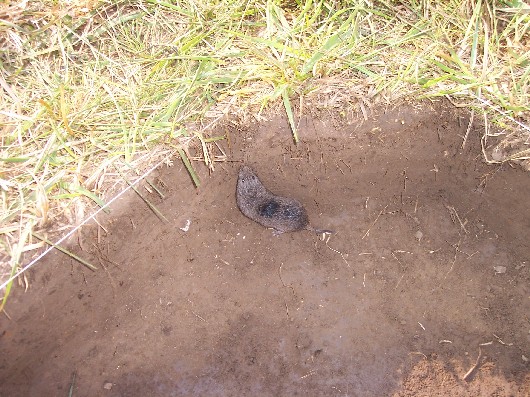

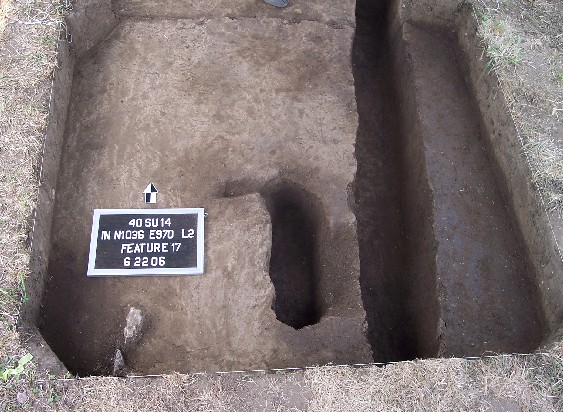
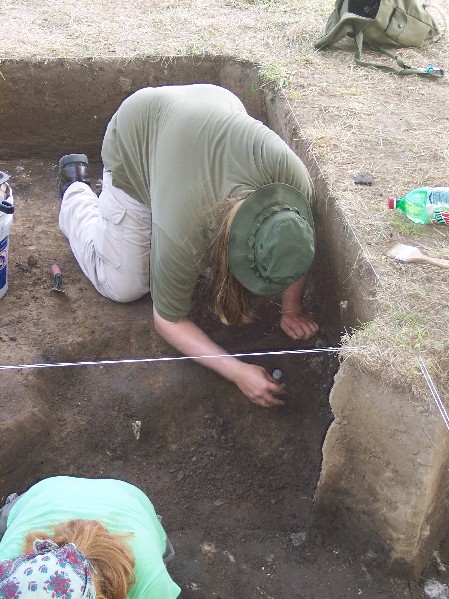
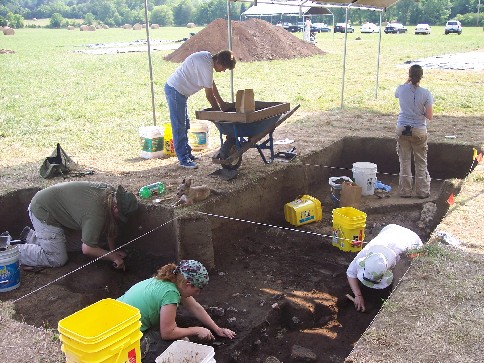
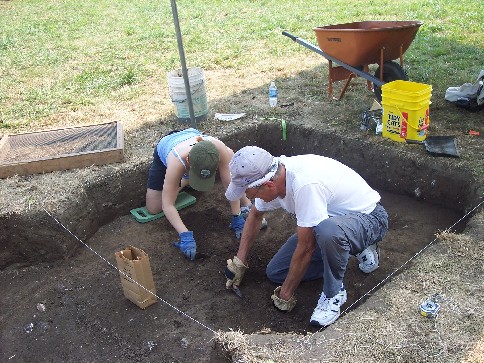
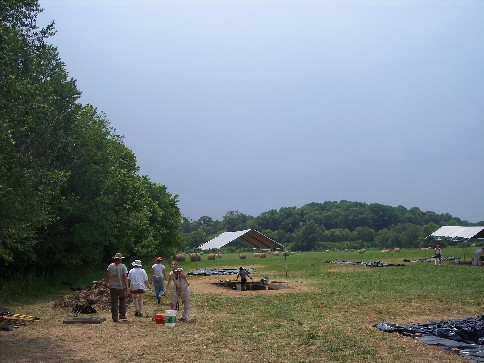
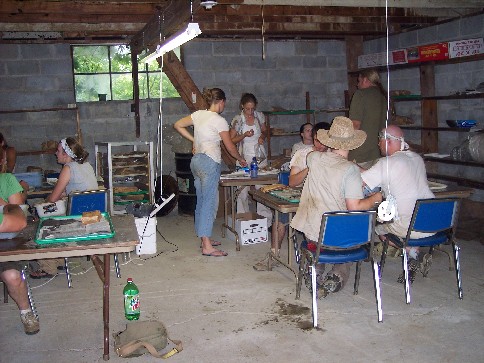
The relatively high possibility of showers and thunderstorms today
meant that we had to evaluate the weather situation upon arrival this
morning. When I left home about 6:15, a line of small thunderstorms was
headed in the general direction of our site. By the time we arrived about
7:15, however, that particular batch of storms had dissipated and we had a
beautiful part cloudy and cool morning facing us. A brief sidetrip to one of the two ponds on the state property provided
us with several turtle sightings -- one of those is surfacing in the
middle of the photo below. We also found some evidence of the local deer around the pond
edge... Although stormy weather swept around various parts of Middle Tennessee
today, Castalian Springs was not amongst those locations. A great day for
digging -- party cloudy and partly sunny (depending on the moment) with a
nice breeze. As a result, we managed to complete quite a bit of
excavation -- but what we found has raised as many additional questions as
the answers provided. In the area of our possible "palisade trench" -- investigations of
other features in two units converged on a simple conclusion. We have
another parallel trench running across both units. Below, Richard,
Natalie, Brandy, Jesse, and Beckah are excavating this second trench. After excavation, we had two parallel trenches running the full length
of these two units (the "old" one is on the left and the "new" one is on
the right in the photo below). With some consternation, while examining some other features in the
same units later in the day... we discovered yet a third trench in between
the other two that appears to run almost the full length of both
units. At this point, with three parallel trenches -- we will have to
re-evaluate our previous interpretation of a "palisade trench." In the
field, we gather information and create hypotheses that best explain what
we see at that point in time. As a science, however, archaeology is also
about continuing to gather more information -- as that new information
arrives, we have to step back and reevaluate our earlier ideas. If the new
information doesn't work with our old hypothesis, then we develop
different or more refined interpretations based on that new info. So, where are we now? While it's possible that we have three
consecutive versions of a palisade surrounding this ancient town (in other
words, a town wall was built, rebuilt slightly off from the original one,
and then rebuilt again), this would be fairly unusual from what we know
about town walls around A.D. 1250. We are retaining this as a possibility
-- but we need some additional evidence to support that notion. Another
possibility is that we are looking at a wall-trench building of some kind
-- a house or public structure. These types of buildings are frequently
rebuilt on the same site -- yielding multiple wall trenches. They are
usually slightly offset to give stability to the walls of the
reconstructed building -- without pest control companies, the wooden
structures of this time probably rarely lasted as long as 30 years.
Those are our two best alternatives with what we found today. So, how do we decide which of these alternatives is the "best"
explanation of what we found today? We need more information. About 6 meters to the north of the three trenches, Jonathan, Barrett
and Beth worked on their excavation -- if these trenches pass through that
unit, we can be fairly certain that we are looking at palisade walls. A
12-meter long trench would be too long for typical houses or public
buildings. What they found only raised more questions -- they found another
trench, but it runs perpendicular to those to the south. The photograph
below shows where we are as of this evening. In the upper center of the
photograph are the units containing the three parallel trenches -- the
black lines show where two of these should probably go if they are
palisade trenches. In the foreground is the "unit to the north" -- the
yellow lines running from left to right outline the trench Barrett,
Jonathan, and Beth discovered. The blue lines are where the continuations
of the "palisade trenches" should be -- but we aren't certain we've found
evidence of them yet. In the far background of the photo, the black lines
cross two of our newer excavation units under black plastic -- we'll work
on those on Saturday and see if we can find any evidence of multiple
parallel trenches. Given our current uncertainties, our simplest solution
is to "gather more information." So, the white outlined areas are
excavations that we will start digging over the next couple of days. While you scratch your head wondering if we have a clue what's going on
-- the answer really is "yes, we do." We've opened the first "windows"
into the earth of this very large Native American town and have already
discovered a number of fascinating and spectacularly preserved features
created almost 1000 years ago. We're down to two possibilities for the
features in this area -- and we have a plan to test which of these two
alternatives is the "right answer." We'll see what happens as we continue
our investigations over the next few days. Elsewhere on the site, we continued investigating our large
pit/structure on the southwestern edge of our excavations. The tents in
the background of the photo below are above the excavation units
containing the various trenches discussed above. While some of our dig
members worked on "Feature 4" -- we opened another excavation to expose
the southern edge. Robin and Lacey are working on stripping the sod from
that new unit. Further work on the "old units" revealed an exciting new discovery -- a
central pit packed full of burned limestone fragments. In the photograph
below, the circular pit/structure described in several past days is
outlined in yellow. The blue outline shows the limestone fragments
filling the new central firepit. In the photo below (from a different angle), the firepit is at the
lower left and the burned bottom of the larger pit structure is
surrounding it. By the end of the day, the "new excavation unit" shown above was well
on its way to being down on the "top" of the southern edge of the pit
structure. Below, you'll see a shot across the previously excavated
portion and the "new" firepit as Robin and Lacey clean up the sidewalls on
the new unit. As of today, our 2006 field season is 60% complete -- we've
demonstrated that this ancient Native American town is filled with answers
to questions we've already thought of -- and with questions that we are
only beginning to formulate. In our remaining 40%, we'll answer a few
more questions -- and we'll undoubtedly raise many more. Fortunately, the Castalian Springs Mound site is now protected by state
ownership -- we will have a chance to continue asking and answering
questions for many years to come. Our investigations of our current "burning questions" will continue on
Saturday -- maybe we'll have some new answers when you check back tomorrow
night!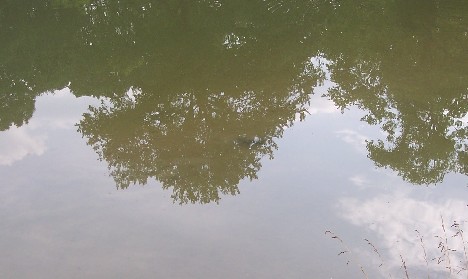
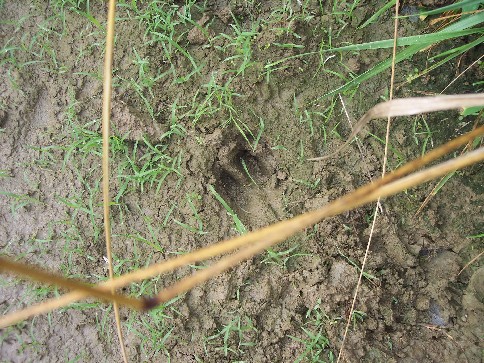
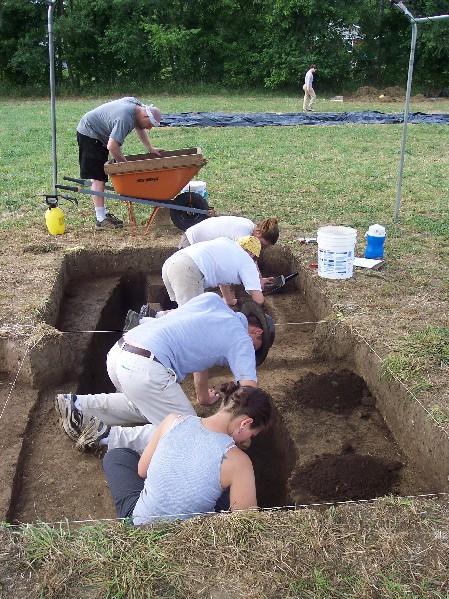
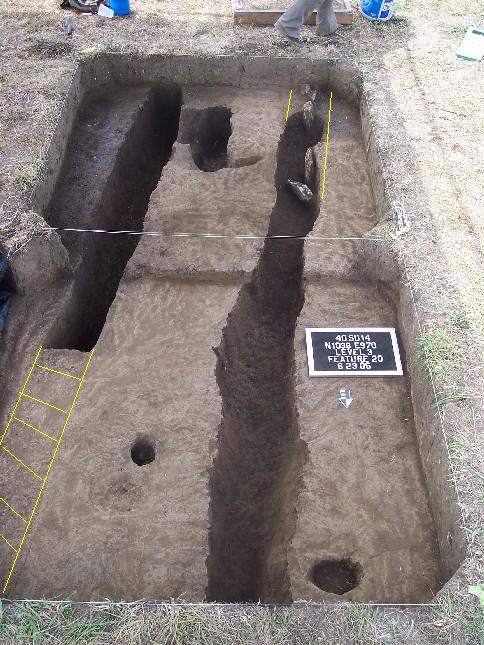
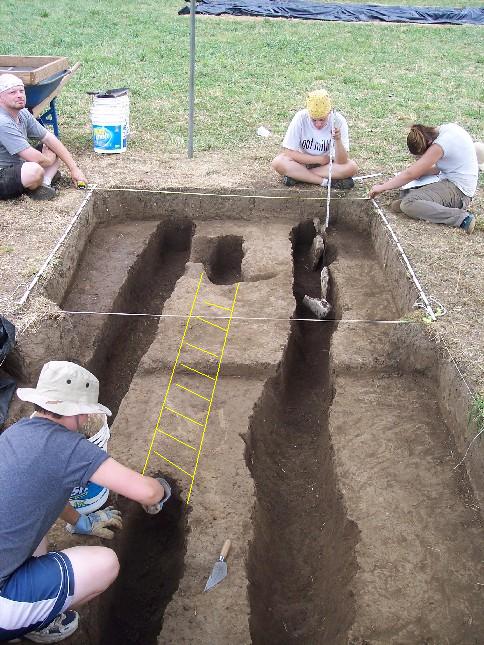
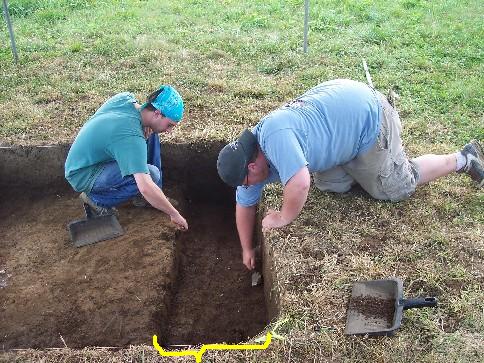
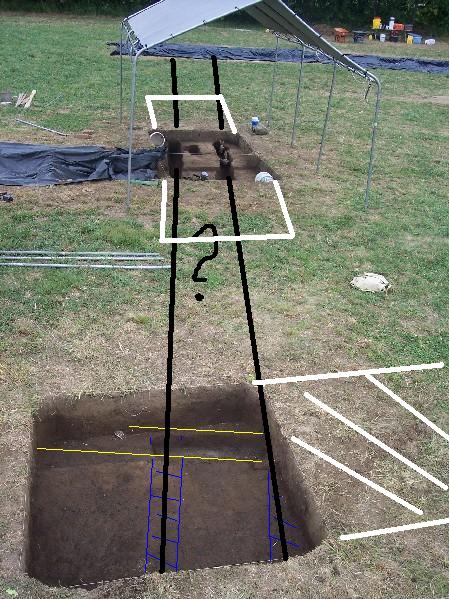
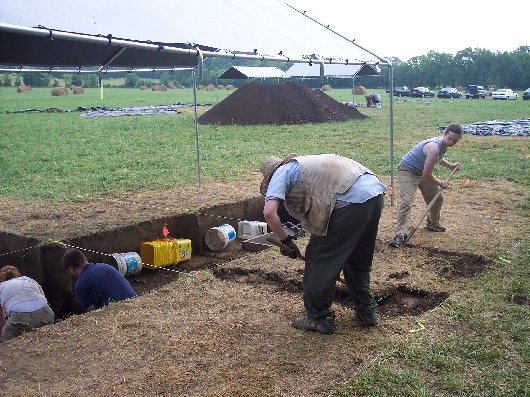

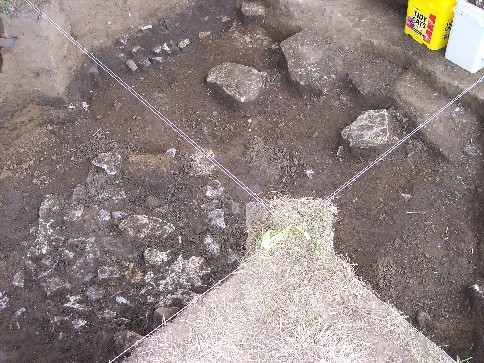
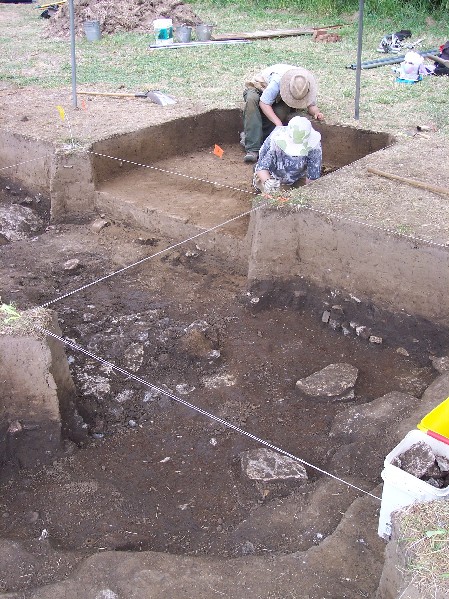
A nice break in the weather continued today -- overcast with a nice
breeze and no rain to interrupt us! The high of 85 or so was much more
appreciated than our recent high of 95+. Today was the third of our four "Volunteer Saturdays" when students
work with volunteers from the interested public as an outreach project.
Our thanks to the volunteers for today: Edward and Marcia Beahm, Howie
and Kay Brainerd, Edie Crane, Georgia Dennis, Ellis Durham, George
Heinrich, Caroline Kiev, Steaven C. Robbins, Lib Roller, Judy A. Shook,
and Angela Stroupe. With the hard work of almost a dozen of our student crew members and
the volunteers, we accomplished a great deal today. We worked on three
areas today: 1) the three trench area; 2) the circular pit area; and 3) a
set of two units to the south of the three trenches. On the western edge of our excavations, numerous students and
volunteers worked on further exposing the large circular pit/structure and
interior features. Below, Erica, Caroline, Edie, and Alex continue to
remove the midden/trash fill from over the floor of this feature. The midden continues to produce a variety of spectacular objects that
will eventually tell us more about the daily lives of the native
inhabitants of this town. The photos below show a fragment of deer jaw, a
large piece of a fabric-impressed pan, and a piece of Dover flint
(probably a resharpening flake from a prehistoric hoe).
Meanwhile, Robin, Lynne, Tracy, and Ryan worked to complete the new
unit down to the top of Feature 4. When we closed up today, they had
removed the circa 45 cm of plowzone and flood deposits. On Monday, we'll
start trowelling that area to find the southern edge of our circular pit.
Below, Robin, Lynne and Tracy take measurements on that unit. A few meters to the east, students and volunteers worked to expose and
excavate the midden-filled pit described a few days ago. Below, Ellis,
Richard, Jonathan, Natalie and Chris are exposing numerous intriguing
artifacts. This "trash pit" has yielded a large sample of animal bones (remains of
ancient meals), pottery fragments, copper, stone tool fragments, and other
remains. While we had hoped to find an extension of our "palisade trench"
in this unit -- we didn't. The reason is explained below. In the units over and around our "three trenches" -- we seem to have
answered one of my "burning questions." Below, Bekah works with Howie,
Kay and Lib to further identify the outlines of the large pit in this
area. Meanwhile, Jesse took on the onerous task of opening a new unit -- with
great vim and vigor, he stripped the sod and excavated the entire unit
down to the top of our trenches (with some able help by Howie). His hard work seems to have answered one of our burning questions --
these are not rebuildings of a palisade trench. They are rebuildings of
an exceptionally large wall-trench house. Two of our three trenches end
-- but one turns a corner to the east. While Jesse worked on this, Emily and Georgia continued excavation of
the middle trench as shown below. Looking from the opposite direction, we have two wall trenches that end
without turning and one that turns to the east. The blue shows the "new
discoveries" today. So, sadly, I abandon my hypothesis that we may have found the palisade
wall for the ancient town. But, happily, I acknowledge the discovery of
an amazing and important large wall-trench house. Sometimes, the answers
to our questions are only a few inches away beneath the earth. Between
our circular pit and this large wall-trench house -- we will not be able
to do much more exploration in the next two weeks. The search for the
palisade wall will have to wait until next year. We are obviously in the midst of several buildings on the eastern edge
of the site -- the photograph below is from 1939 excavations of a similar
site in Henry County. It shows a series of wall trench houses -- note
that the one in the center of the photo has numerous "rebuildings" of
walls. Image courtesy: July 18, 1939; 16HY1 Williams Site 1HY1, Henry
County, Tennessee. Photograph of "street". Rectangular trench and postmold
pattern. Structures in order away from camera - Feature 15, 24, 25, 19,
22, 23, 26, 27, 20. Squares 12L13 to 15R4. Direction north.; Frank H.
McClung Museum WPA/TVA Archive (fhm01003) In the next two weeks remaining to us -- we'll focus on examining the
circular pit/structure and the wall-trench house in detail.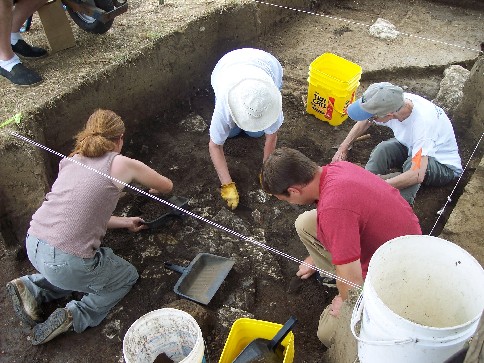

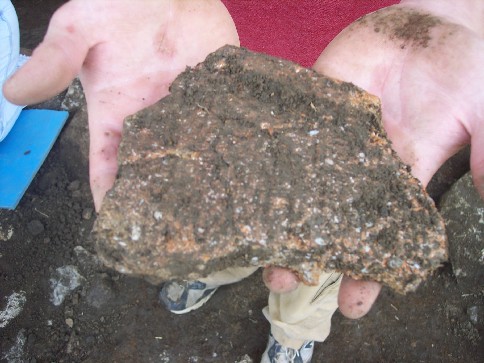
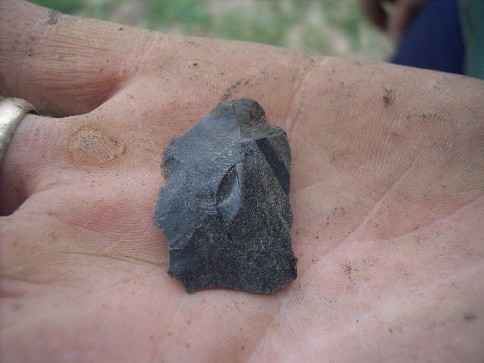
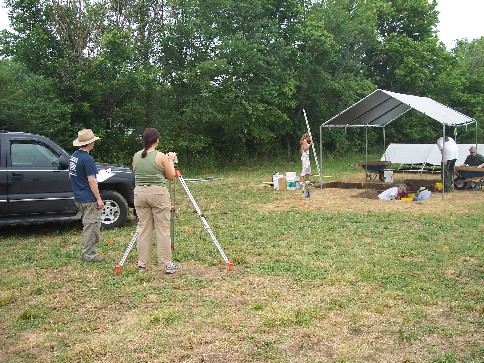
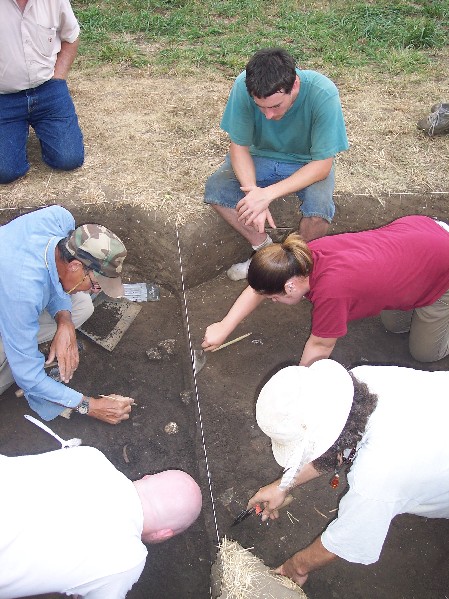
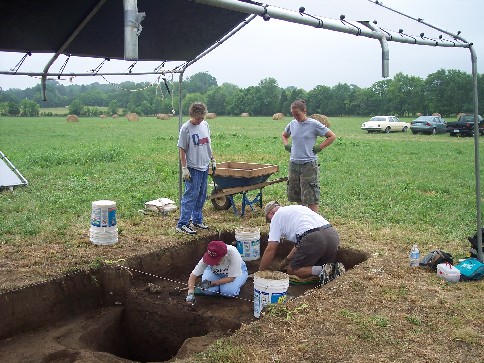
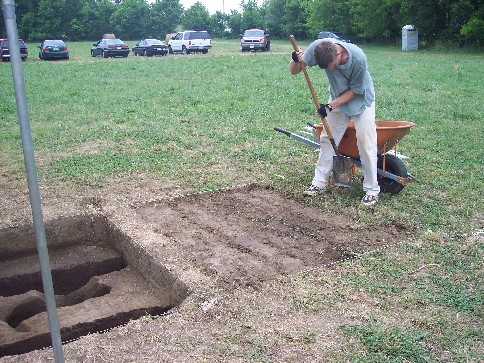

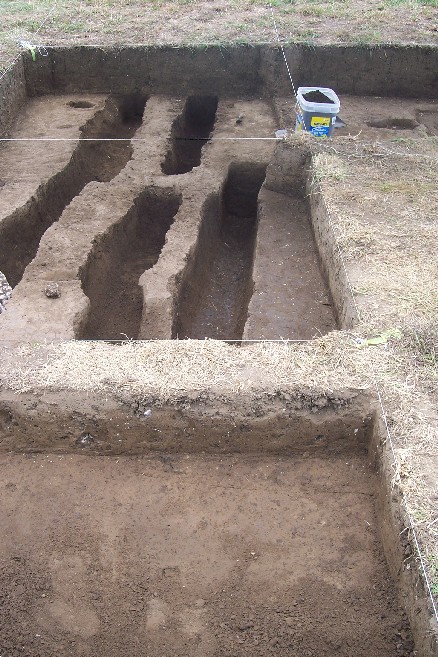
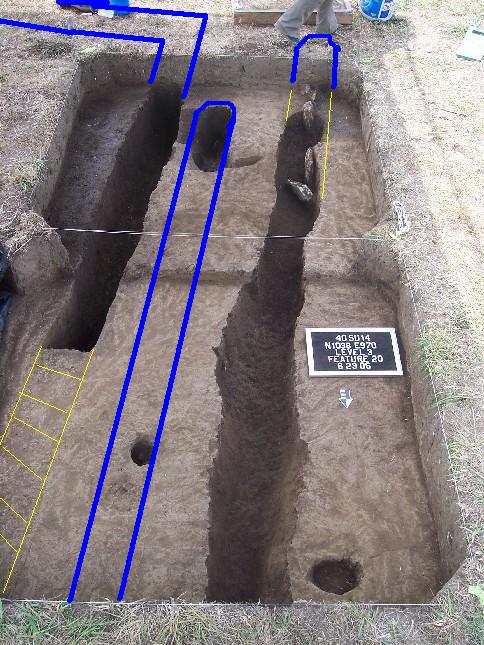
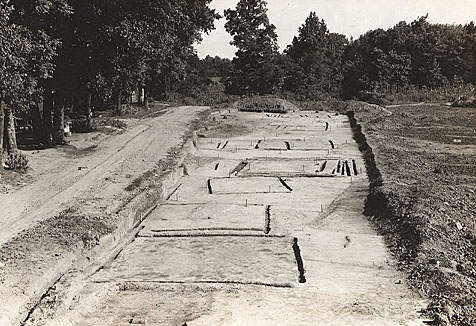
Our return to great weather for digging continued today -- a little
humid, but with temperatures still in the 80s, overcast for most of the
morning, and a nice breeze (well, at least for those that weren't in the
deeper excavations). We focused our efforts today on three features -- 1) the trash-filled
pit on the southern edge of our excavations; 2) the wall-trench house on
the northern edge of our excavations; and 3) the circular pit/structure on
the western edge of our excavations. We almost finished the trash-filled pit on the south -- Barrett, Beth,
Jonathan, Brandy, Natalie, and Richard continued to excavate this pit
today. Only three work days ago, we were just exposing the top of this
pit... It has produced an enormous amount of pottery, animal bones, and other
artifacts discarded by the inhabitants of this town some eight or nine
centuries ago. Among the several hundred objects recovered today was a
spectacular example of fabric impressed pottery -- showing multiple bands
of different weaving styles. Among the several hundred pottery sherds discovered in this pit today
is a large decorated handle from a pot. And many more fragments of animal bones
from meals long past -- including several box turtles. Up to our wall-trench house to the north -- Jesse, Meagan, and
Bekah exposed enough of the features to define them a bit better.
With our work today, it appears that we have some overlapping posts
and fireplaces from different rebuildings of the structure. The
photograph below shows what appears to be a burned post (circled in
yellow) along with a probable hearth (circled in blue). With space at a premium in this ancient town, buildings were rebuilt on
the same location over and over again as the years passed. With the
construction techniques available and without termite, pest, and vermin
control, these buildings were probably torn down and rebuilt every 20 or
30 years. Sometimes they were built the same size -- in other cases, they
were expanded (probably to accomodate larger family size or increasing
affluence). Given that our structure was rebuilt at least twice, we can
estimate that this building was there for at least 50-100 years. In order
to determine whether it was rebuilt the same size or larger, we'll have to
expand our excavations to determine the length of the south wall and find
the other corner on the west wall (shown in blue below). Over on the west side, three of our crews worked to finish
exposing the circular pit/structure. With apologies for the bad
light in the photo below -- we have found the southern edge of the
feature and are beginning work on the missing pieces in a few spots.
From the work today, it seems possible that we have an "entrance"
into the pit from the east (on the upper part of the photo). The
fire pit in the center also seems to be a solid and well defined
feature at this point. We'll continue excavations here on Tuesday
-- and have some better overall photographs for tomorrow's web
page. If the weather holds, we should have a much better picture
of these two buildings over the next couple of days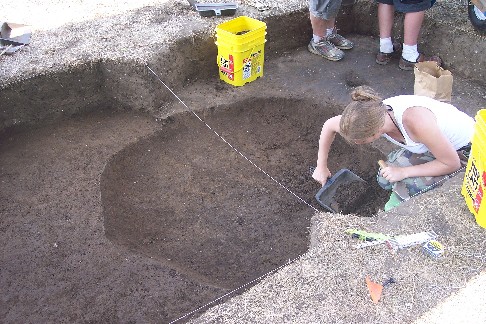

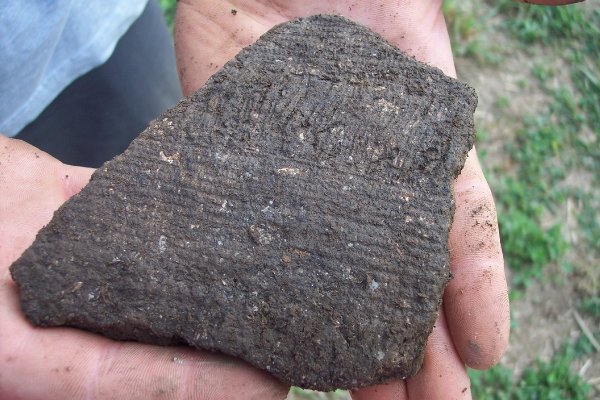



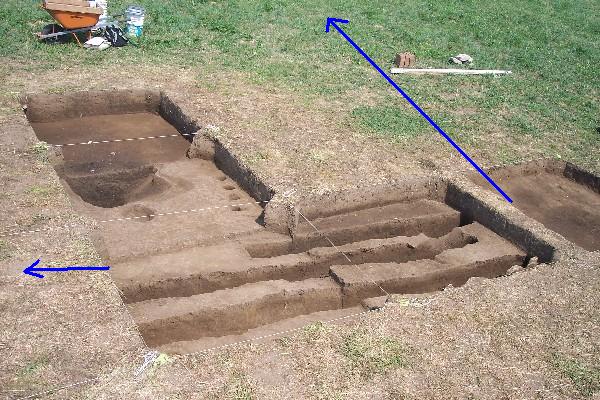

The weather continued in our favor today -- temperatures in the 80s
with some nice clouds and a great breeze. Exploring a bit more of the new state property, this starkly beautiful
but almost dead tree was the perch of one of our hawk friends this morning
(sitting on a branch on the left side). A telephoto shot shows a bit more detail after the hawk hopped over to
another branch... We continued work in our three excavation areas today (in the morning).
Beth, Barrett, and Jonathan finished up excavations of the pit feature and
will finish paperwork on it on Wednesday. Over on our circular pit/structure, we completed cleanup of the next
excavations for photographs and drawings. As we expose more of the entire
feature, we start to get a better understanding of it. Further
excavations of these areas on Wednesday will undoubtedly reveal new
artifacts from the garbage filling it -- and some new clues to its
original purpose and function. Jesse, Bekah, and Meagan continued work on our features near the wall
trenches today. As a reminder, we thought we had identified a large
posthole yesterday (outlined in yellow)... Below, Jesse is carefully working on that large posthole... As the team proceeded deeper into the "possible" posthole, it turned
into a "definite" posthole... The photo below shows the carefully exposed
remnants of a carbonized post fragment still surviving in the hole... Proceeding deeper, we discovered something even more amazing --
fragments of this large post are preserved unburned. We began to recover
sections of red cedar like those below... By the time we closed up for the day -- we had exposed a very
large cedar post. As shown below, it is partially carbonized on one
side and unburned on the other. We have hopes that excavations on
Wednesday morning will reveal another foot or so of preserved post
that we can retrieve for future analysis. We were visited by two of our annual volunteers -- Will and Wade
(grandchildren of our old friend Carrie Mabrey). Below, I'm showing them
some of the discoveries of the day. These guys are not just here to look though -- they always insist on
pitching in full speed with archaeological "diggings." Last year, they
dove into our project with shovels in hand ... This year was not different. Richard and Natalie had started
excavating
another unit to expose another corner of our wall trench house...
Will and Wade once again took shovels in hand to assist us in our
work... After lunch, I decided we should do our annual tour of Wynnewood and
Bledsoe's Fort Park -- and postpone continuing our digs until Wednesday
morning. The
crew has been working super-hard and completed an amazing amount of work
in only three weeks. While we have a lot left to complete -- we also need
to take some "downtime" to both rest up and to expand our appreciation of
the amazing historic and prehistoric sites within walking distance of
where we work. Our new friend Nettie Bates and old friend Lee Myers provided a tour of
Wynnewood for the team... And we continued our tradition of traveling the trails in Bledsoes
Fort Historical Park where many past years of MTSU field schools have
toiled to discover things about the past of this community and
Tennessee. Back to the "Digs" on Wednesday morning -- hopefully refreshed and
invigorated for our last few days of fieldwork this summer.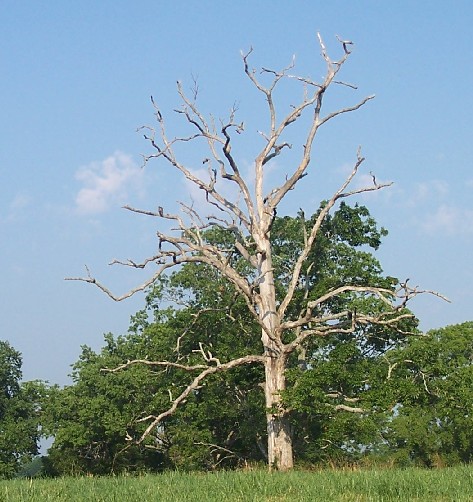




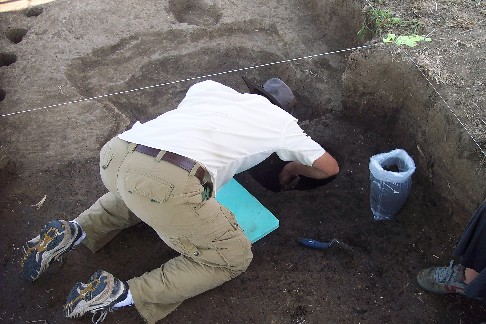

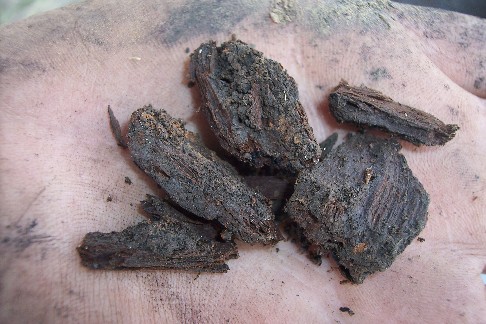
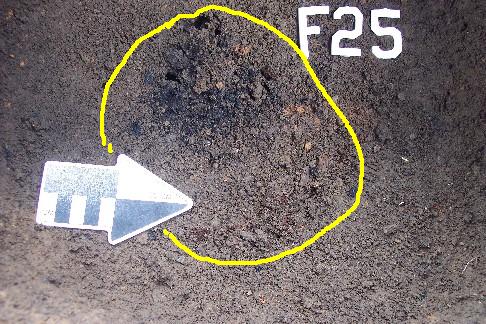
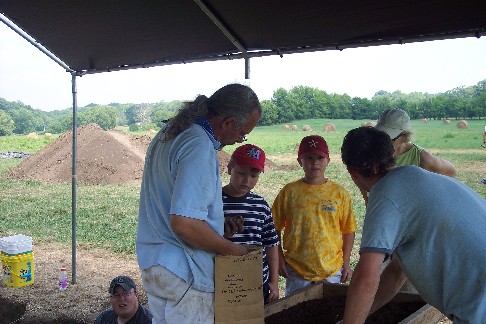


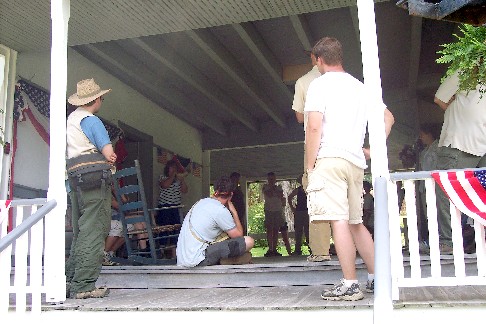
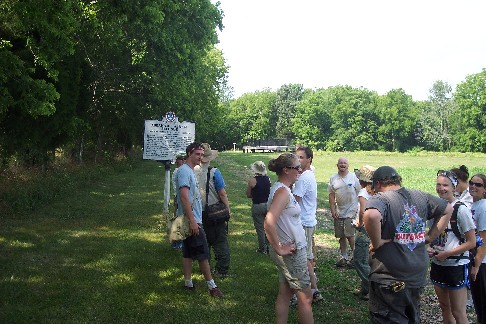
Another beautiful June day as our project end nears. Our crews are working across a large portion of the southeastern corner
of this ancient town. While we've moved a tremendous amount of dirt in
only four weeks -- we've touched only a tiny part of the mysteries held
beneath the surface. Slow work continued on "Feature 4" today -- our large circular pit
feature on the western edge of our excavations. Below, Robin carefully
exposes a deer scapula while searching for the edge of this feature. About six feet to the north of Robin, Jennifer, Lynne and Tracy are
cleaning up another new excavation unit exposing the outline of
Feature 4. Once they finished their work, one more edge of the circular pit
was clearly identified -- one more piece in the outline of the
enigmatic but important feature. Elsewhere, Jonathan and Barrett continued work mapping the several
features in their unit. The features outlined in yellow are pits that
were later filled with trash. The blue outline is a probable posthole to
be mapped first and excavated later. The white outline is a small rodent
burrow at the bottom of one of the trash pits. Now and over the next few days, crew members are moving from area to
area as needed to help with various recordkeeping tasks. Jennifer moved
over to help Jonathan and Barrett finish mapping their features while her
crewmates were busy with some tedious cleanup work. Our work on the large wall-trench house continued -- we finished up
another excavation unit to the north. The three trenches we had already
identified continued all the way across this unit (shown in white, yellow,
and blue). To our surprise, we also found yet another trench (in black)
-- our wall-trench structure was not only large, it was rebuilt at least
three times. In addition, our large post continued to be an intriguing feature --
the photo below shows this features in cross-section. The yellow circle
surrounds a large piece of intact post remaining in this feature. In the late morning, some alums of the Castalian Springs Project
dropped by to visit and volunteer. Mitch and Tyler were crew members last
summer (and graduated recently). After receiving an orientation from
Alex, Mitch, Tyler and Teresa opened a new excavation unit in search of
the south wall of the wall-trench house. We're at a tedious stage of work -- things will pick up as we get
different areas cleaned up for larger scale photographs in the next few
days.
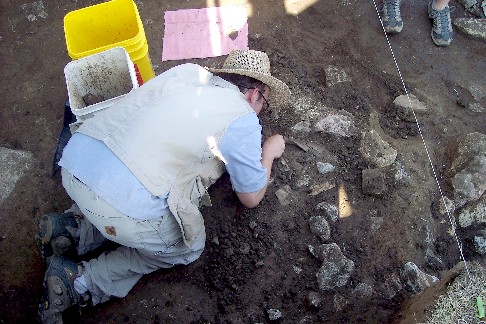
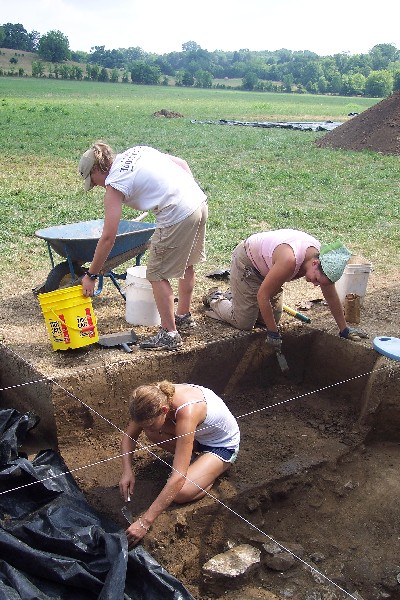
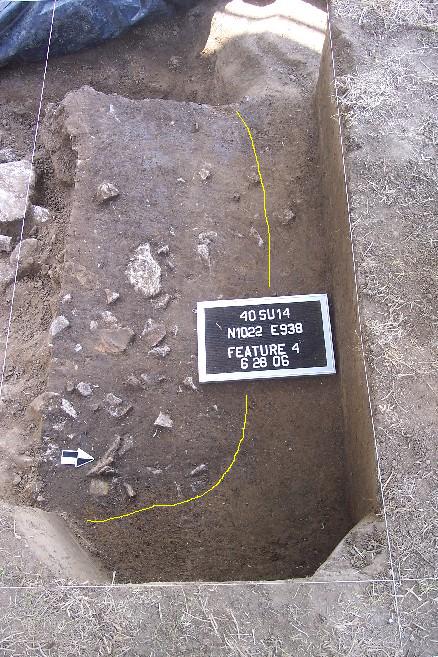
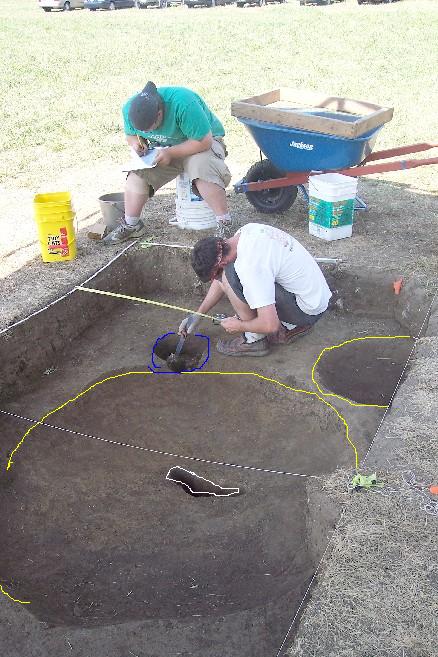
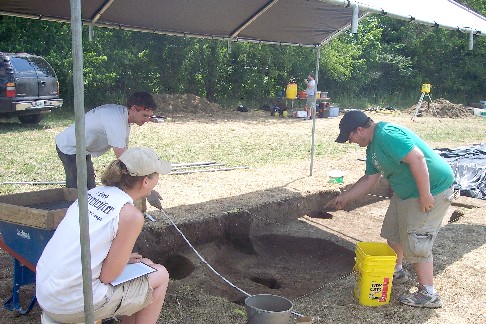
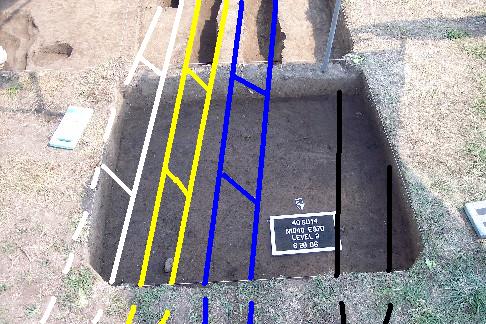

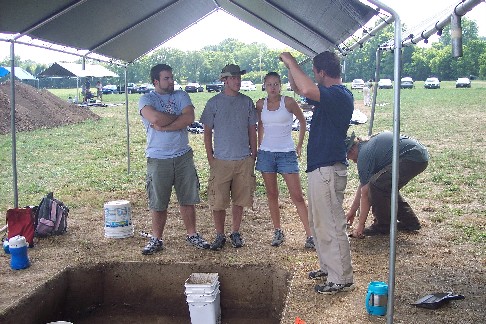
We really couldn't ask for better weather for a late June Tennessee day
-- low humidity, a great breeze and temperatures in the 80s. Our project found a "mascot" in the last few days -- this young bird
has adopted us. She has shown an exceptional interest in our work --
hopping in and out amongst the units and hanging out with the crew during
lunch. While her interests may be purely archaeological, we suspect the
numerous worms we're turning up in the excavations may be of greater
interest. While I'm not certain, I think she may be a young female
red-winged blackbird. We continued our careful excavations of Feature 4 -- the large circular
pit-structure. Below, Jennifer, Katie, Alex, and Lacey work on various
units exposing the outline of this feature. In their excavations of Feature 4, Lacey and Robin finally found
a very clear outline of the pit on the south side -- the yellow
arrow points from the outside (yellow/orange clay subsoil) while
the blue arrow points from the inside (dark brown midden fill). To the west, Erica worked on finishing one more "corner" of the pit
feature -- the yellow line shows the boundary between the dark midden
inside the pit and the clay subsoil outside the pit. As the digging continues -- so does the paperwork and documentation.
We are drawing and photographing the "profiles" of each excavation unit --
the side view that shows the different layers of soil. The photo below
shows some of the different layers of soil over Feature 4. The area above
the white line is the sod and plowzone. Below that are two more soil
layers -- the dark soil between the yellow lines is the fill in the pit
feature. We also had some distinguished visitors today -- Dr. Jim Knight from
the University of Alabama and Dr. George Lankford from Lyon College in
Arkansas. In the photo below, Drs. Knight and Lankford (center) are
observing Meagan and Jesse excavating the interior of the wall-trench. Jim chipped in with some wheelbarrow runs for the students... We greatly appreciated their input and thoughts on the excavations,
features, and artifacts recovered so far this summer. Some of the research faculty on our project also stopped by today --
below, Dr. Tanya Peres (Project Zooarchaeologist) and Dr. Shannon Hodge
(Project Bioarchaeologist) discuss our progress with Emily. Back up at the wall-trench structure, we continued opening new units to
follow the walls of this structure. Below, Beth exposes another section
of the north wall of the structure... While on the south wall, Brandy, Natalie, and Richard
finished up the unit opened by our alums yesterday. The south
wall trench clearly continues (outlined in yellow) and contains
two intriguing pieces of burned wood (noted by blue
arrows). Over our last few days, we will be working both slowly and
quickly -- finishing up our detail work and paperwork on
previously excavated areas and opening some new areas as
quickly as possible. More on Friday...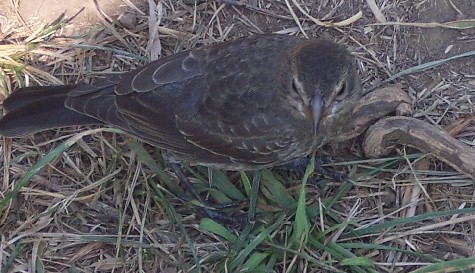

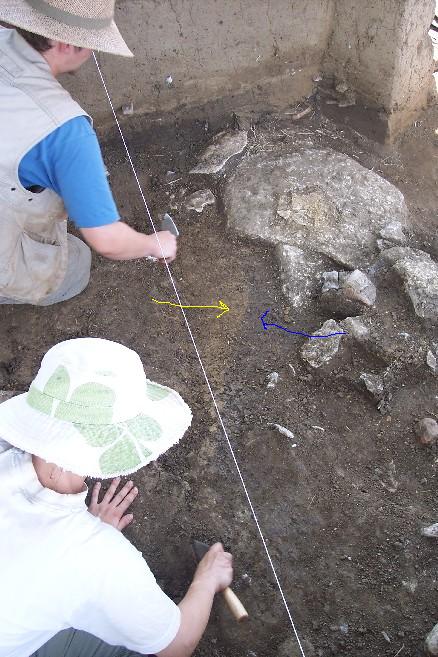
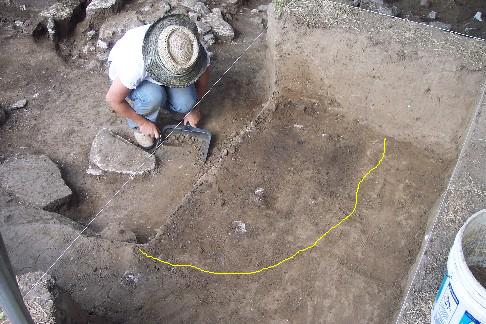
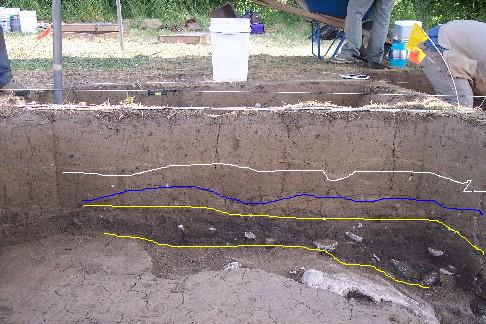
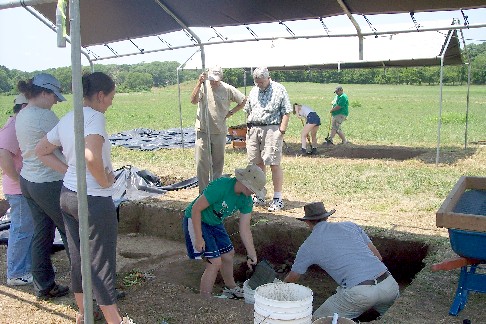
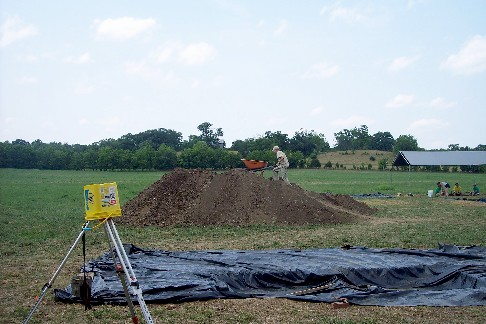
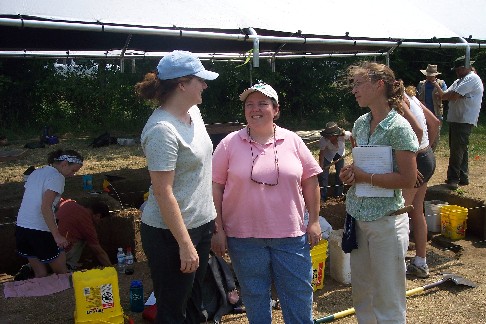
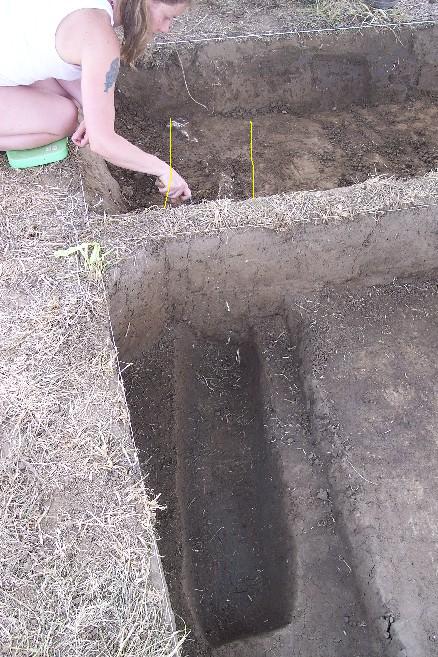
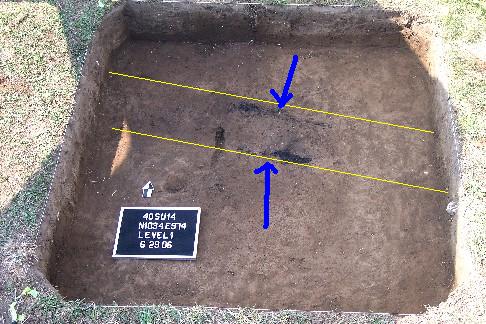
While a bit more humid and without a breeze in the morning, we were
stilled blessed with pretty good weather for the last day of June 2006.
The afternoon was cloudy with a nice breeze -- although we did have a
brief anxious moment or two when some dark clouds threatened to head our
way. Two rain drops out of those -- we saved them. Our "digs" continued slowly today -- not a tremendous amount of great
discoveries to report. Below, Meagan continues to work on the pit feature
surrounding the large post we've been working on for several days. From another angle, Jesse works to expose the outline of this pit --
we're still not sure what this feature is. Here's how it looked after "cleanup." Much of the crew continued working on Feature 4 -- we weren't quite
ready for a large-scale aerial photo of the feature when we closed up
toady. Maybe on Saturday... On our wall-trenches -- we continued work. On the north wall of the
trench-house, we found our second corner (outlined in yellow). To our
astonishment -- we found what appears to be the end of Wall-Trench Number
5 on the west wall (in white). That would mean this large structure was
rebuilt at least four times. The black outline at the bottom of the photo
shows several different features -- a probable small hearth and a
posthole. More news on that either tomorrow or Monday. Tomorrow is the last of our "Volunteer Saturdays." We look forward to
working with our volunteers -- and hope to report back some great progress
on Saturday.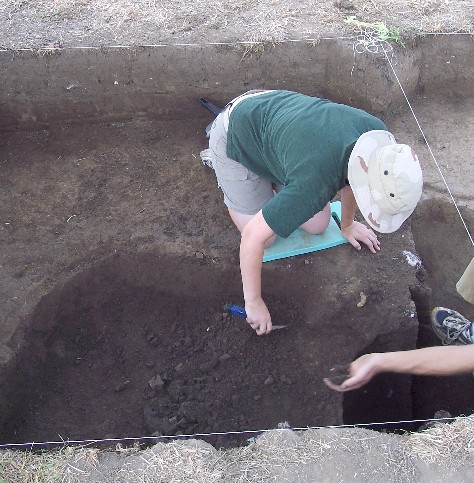

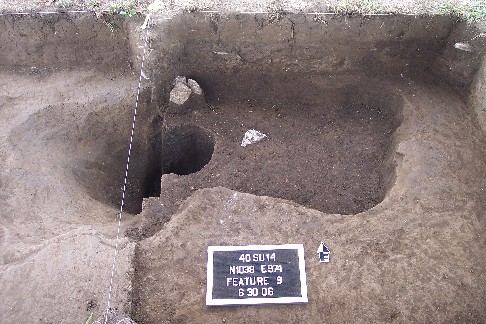
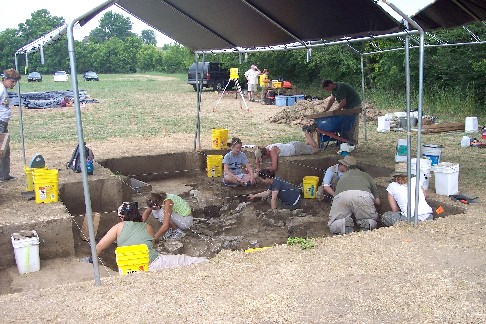

Today the weather shifted a bit more to the "gosh, I'm sticky" kind of
weather. It was a bit hard to tell whether we were actually sweating, or
just condensing some of the abundant moisture out of the air. With
temperatures in the low-mid 90s (almost matching the ambient humidity),
the breeze in the morning was greatly appreciated. The lack of a breeze
in the afternoon was received with somewhat less enthusiasm by the crew
and volunteers -- but it at least gave us something to talk about. Arriving a bit early, we once again took the opportunity to look around
a bit of the new state property. Passing the barn, we noticed some new
additions -- several fearless young barn swallows were resting on the barn
gate waiting for Mom to bring them some food. We also discovered a third, very small springfed pond. Covered with
algae, but home to a number of turtles. The "shoreline" of this small pond also shows evidence of the frequent
visitors from the local community -- the animal tracks include deer,
turkey, rabbit, raccoon, dog, and others. Today was the last of our Volunteer Days for this summer field session.
We appreciate the assistance and comraderie of our volunteers for the
day: Edie Crane, Georgia Dennis, Susan Finger, Ann Funkhouser, Elaine
Hackerman, George Heinrich, Caroline Kiev, Lib Roller, Jeff Stewart,
Virginia Vesper, and Mike Warren. We also had visits from the family of several of our student crew
members today -- Jesse's parents stopped by to view his "digs" along with
Natalie's mother and father and Brandy's mother, grandparents, and
sister. We continued work with our volunteers on the "circular pit" and the
"wall-trench house." Below, experienced archaeo-volunteers Jeff and Mike
start excavations of a section of the south wall-trench. While volunteers Caroline and Edie work with Lacey and Robin on two of
the wall trenches on the west side of the building. To the north, Lib worked with Jonathan and Beth on the north wall of
the structure. Mike discusses the weather with our old friend Susan Finger who showed
up to help with the screening (her mother is supervising on the right).
In the background, Jeff is excavating portions of the south wall trench,
while Brandy and Richard work in the background on a new unit that
revealed our first glimpse of the east wall. Meanwhile, Jesse and Natalie worked with Georgia and George on the
large post and pit that now appears to be in the center of our wall trench
structure. As excavation proceeded today, we discovered a second large
posthole. The photo below shows our first large posthole in yellow -- the
new large posthole (probably associated with a rebuilding of the
structure) is outlined in white. The blue outlines are slanted "ramps"
next to each posthole used by the ancient inhabitants of this town to
slide these enormous posts into the holes and then tilt them up for final
placement. The wall trenches of this building continue to produce some interesting
bits of ancient garbage -- the photo below shows the pharyngeal teeth of a
freshwater drumfish. Each of the holes in this bone once contained
grinding teeth for this native fish. At the close of the day, we have identified portions of four
walls of the structure -- along with three of the corners. Only
one more corner to go! The photo below shows the south wall of the building in yellow
-- along with the newly discovered segment of the east wall in
blue. Back over at our "circular pit structure," several volunteers
and students continued work. Below, Lynne supervises as her mom
cleans up a part of "Feature 4." Virginia works at the screen. In a nearby unit, Alex works with volunteer Elaine on another
portion of Feature 4. The trash filling this circular pit continues to produce some
intriguing artifacts discarded by the inhabitants of this town.
Below, Tracy shows off a large portion of a cooking pot. Alex and Elaine unearthed yet another beautiful piece of
fabric-impressed pottery. Later in the afternoon, Georgia continued working on this
feature. By the close of the day, we had exposed almost the entire
outline of this four-meter diameter pit. The picture continues to
match our interpretations from yesterday -- a large circular pit
with what appears to be an entrance ramp from the upper left
(outlined in yellow). The blue outline shows what we anticipate to
be the firepit in the center of the structure. Overall -- a great day in the Castalian Springs neighborhood. Thanks
to our student crew and volunteers, we are several steps closer to
understanding our two buildings. We have a lot of work to do in the next
few days -- our project closes down on Friday. But for now -- a day off
for the crew! Check back with us on Monday evening for another
update.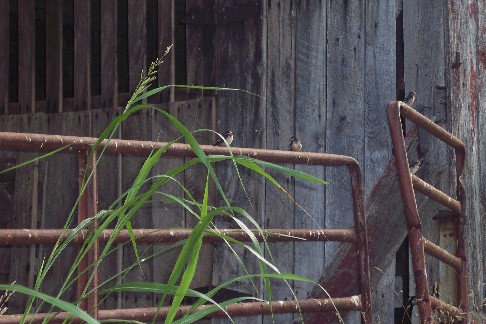
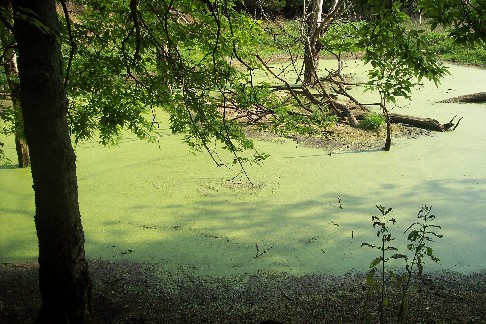
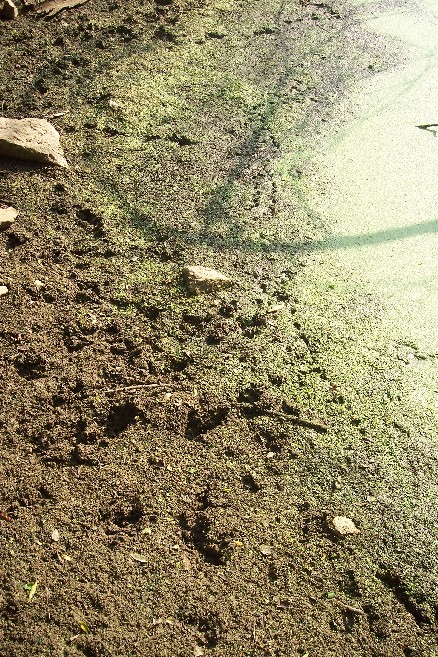
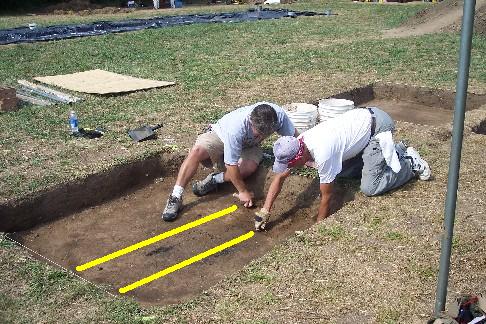
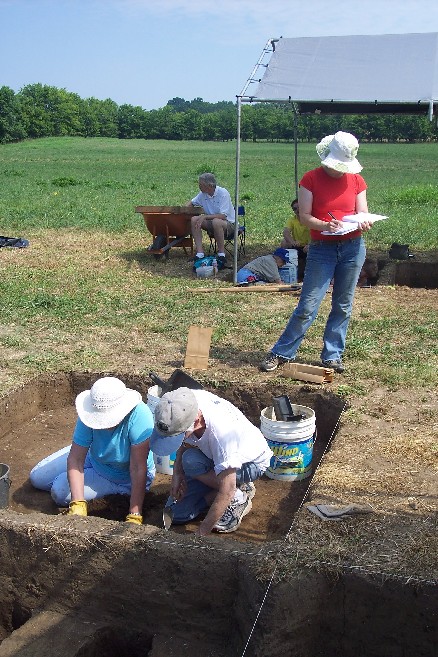
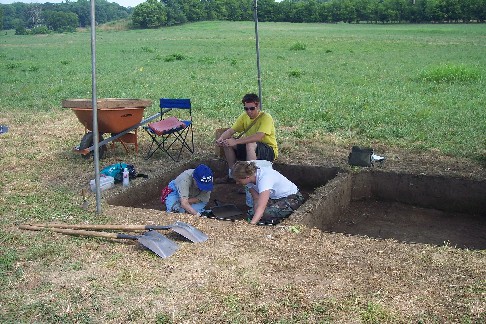

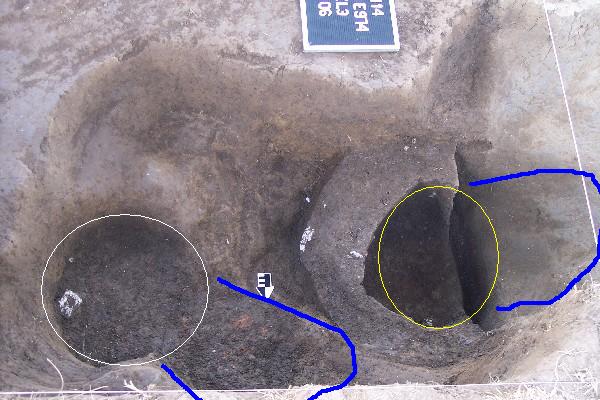
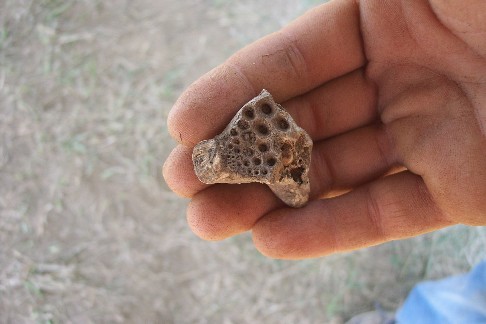
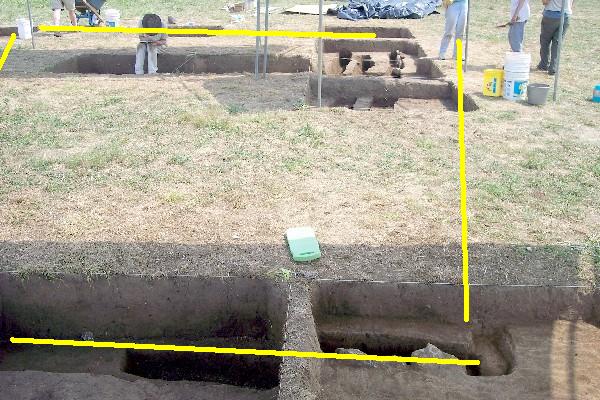

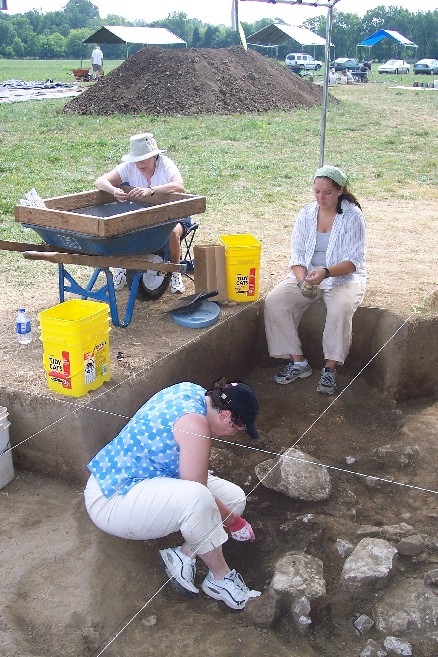
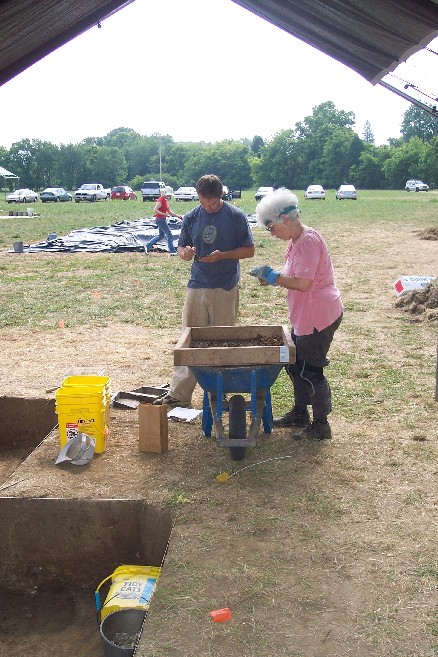
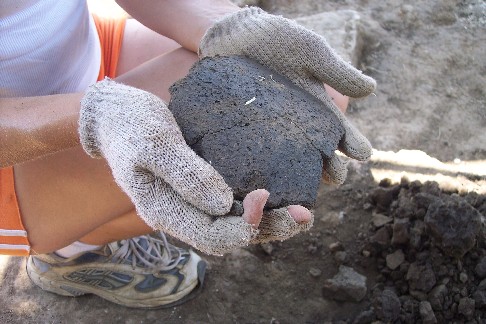

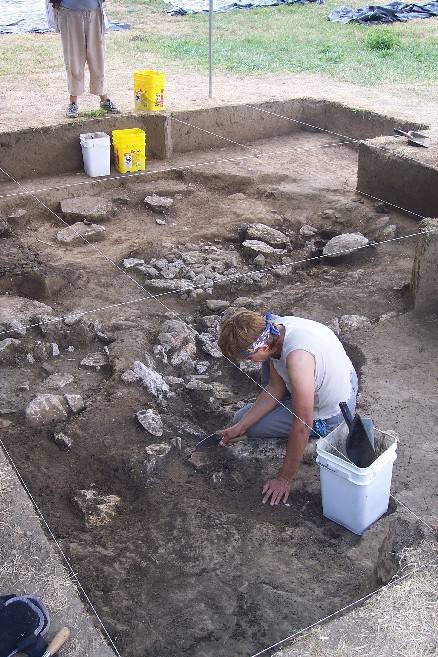

Today, the weather shifted from "gosh, I'm sticky" to something a lot
less pleasant -- something in the range of "I'm the bacon, you're the eggs
-- our site if the frying pan." We worked from 8:00 to 1:15 -- and then
took lunch. With temperatures rising into the mid-high 90's on site, we
moved into the field lab for the afternoon. Much of our work this morning was slow and tedious -- finishing up
details that have to be completed before we can complete our
excavations. We focused on some final cleanup on "Feature 4" -- our
circular pit feature on the western edge of our dig. Below, Erica continues excavating down to the bottom of one "corner" of
this pit feature. The cleanup work continues to reveal a definitive edge on this pit --
as shown below in the area cleaned up by Robin this morning. We should have some nice overhead shots of this feature by Wednesday
evening. Elsewhere on site, Emily and I finished up some mapping, drawings, and
photographs on several units like the one shown below that has two large
pits and a posthole (outlined in yellow). Over at our wall-trench house, most of the students worked on
excavating the center postholes and sections of wall trenches today. Below, Jesse finishes up excavations of the large and deep postholes
(with assistance from Meagan and Bekah)... Brandy, Richard and Mike worked on our east wall trench -- confirming
our third corner of the house. The yellow outline is the eastern wall
trench -- the blue is the apparent end of the south wall trench. We'll
have to confirm that on Wednesday. Directly to the west, Natalie and Lacey worked on another section of
the southern wall trench -- exposing the top of the entire trench and the
two apparent small logs at the edge of the trench (in blue). Over on the west wall, Katie, Alex, Tracy and Lynne worked on finishing
excavations of several sections of the trenches of this structure. Out of camera range, Beth, Barrett, and Jonathan opened a new unit to
confirm the northwest corner of our house -- more news from them on
Wednesday. Mid-day, we had another visit from several of our much appreciated
local Sumner Countians -- Mark McKee Jr., Bill Bell, and John Garrott.
These gentleman have helped us out on many occasions during the
project. And then -- we headed to the shade to work on washing artifacts. In
the shade up the hill, it was only in the upper 80s -- seemed like
air-conditioning after the early afternoon heat. More news on
Wednesday...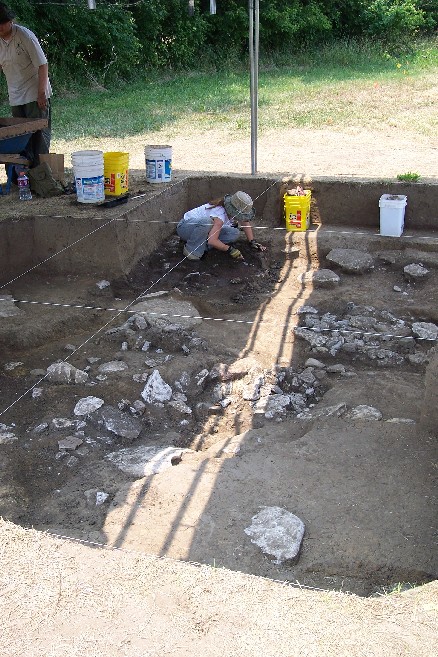


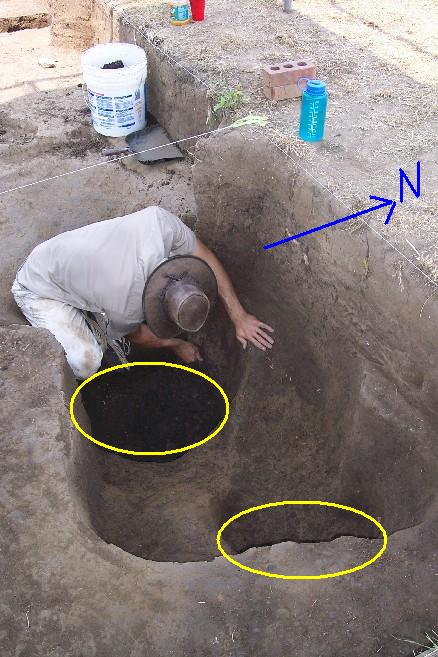
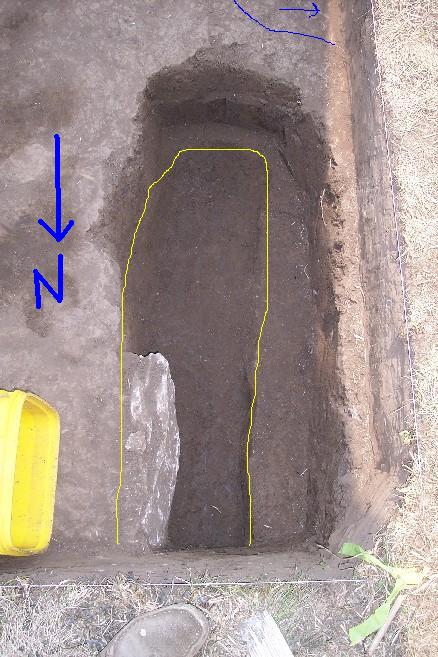
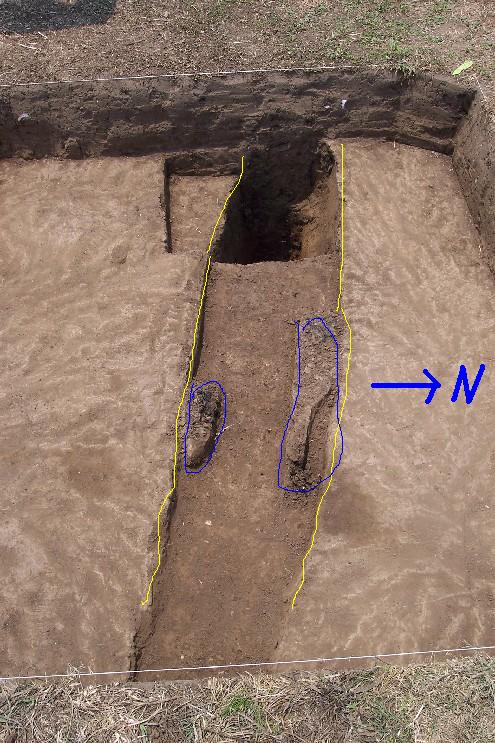
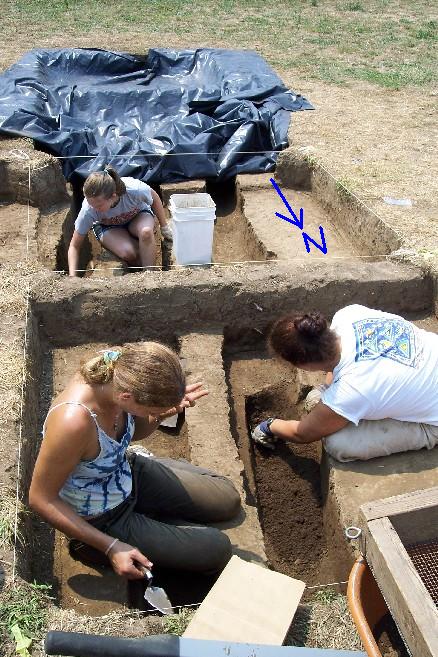
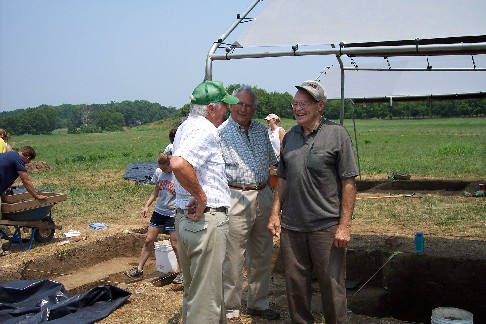
When I arrived a bit after 7:00 this morning, it was enormously
comfortable in terms of temperature compared to Monday. Then, again, that
may have had something to do with the pouring rain. Archaeology -- like any other occupation that requires work in the "out
of doors" -- requires practicioners to play the cards that nature deals.
Unlike many traditional college classes where a day of rain may just mean
an uncomfortable walk from the parking lot, our class has to manage an
8-hour class day. And, the summer field course is also an experiential
learning course -- designed to expose students to the "real world" of
archaeological fieldwork. Not just a picture of it on a screen in a
classroom. Our course is not exactly the same as working as an
archaeological field technician -- but it is a lot closer than just
sitting on campus. Like the real world, our project also has a deadline for completion.
While earlier in the project we might have just taken the day off and
worked in the lab, we are now pinched for time to finish up our tasks.
It was an uncomfortable day -- we worked through the constant showers,
dodged the harder rains as best we could, and completed quite a bit of
work before closing up. We can't begrudge the rain -- it was much needed
by the farmers and folks that live in Castalian Springs. Many a crop was
saved by the rain today. Like the farmers, we wish it had happened a
couple of weeks ago though! Only a few photos for today -- the rain disagrees with my digital
camera... Below, the students form several "bucket brigades" bailing the
water from our plastic so we can open up the units. I must compliment our student crew -- they understand how much "stuff"
we need to finish in the next few days and chipped in despite being soaked
multiple times without complaint. Many of them have volunteered to come
out on Saturday after the class is officially over and help finish up if
needed. Our field class is not simply about "class starts on June 6 and
ends on July 7" -- it is also about 20 folks learning to work together as
a team, knowing the goals, recognizing the obstacles like today's rain,
and figuring out what we need to do to finish up ahead of the game.
Sometimes, it's about patiently holding an umbrella over the head of your
crewmate in the middle of a field in the pouring rain so their paperwork
doesn't get wet while your other crewmate takes measurements. As we packed up -- after being soaked for the 5th or 6th time --
everyone remained in good spirits. But, we're all ready for promised
better weather on Thursday and Friday. On Thursday, we'll be focusing our efforts on finishing up "Feature 4"
(our big circular pit/structure) and the wall-trench house.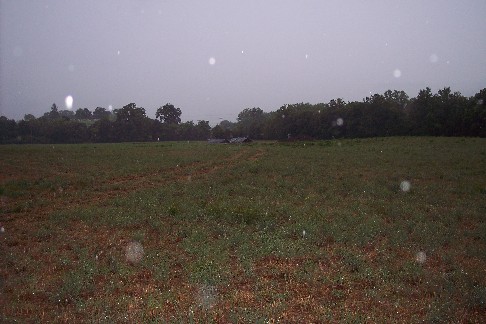
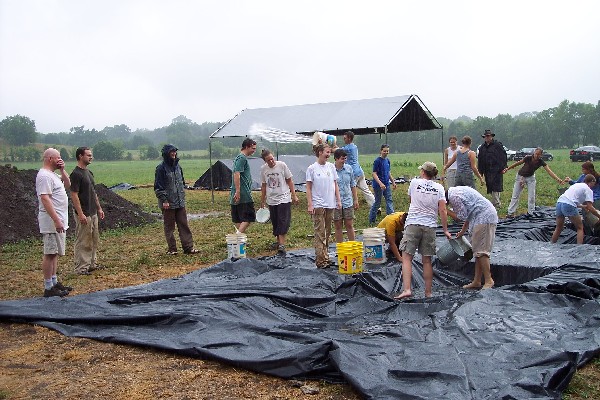


The promised "perfect weather" for archaeology did arrive today --
low humidity, a great breeze, and more than comfortable
temperatures. The entire crew worked diligently today to get us quite a bit closer to
finishing up on Friday. Many of us took a short lunch -- and several
stayed until 7:00 pm. We completed most of the remaining work on our wall-trench structure
today -- at least the parts of this giant building that we have exposed
this summer. Other parts of the walls and interior will remain for future
investigation. The image below shows a schematic (and not quite to scale)
view of this building. The black squares are our excavation units while
the yellow areas are the wall trenches and central posts. We have three
good corners on the northwest, southwest, and southeast. Since these
buildings were rectangular, we can reliably predict the location of the
northeast corner. The building was rebuilt at least three times, so there are four
trenches on the west for the four different constructions of this
building. We even suspect that there is a fifth construction of the
building -- and maybe even more -- outside our excavations to the west.
While we only found two trenches on the north and east -- there may be
others outside our excavations. On the south, we currently only have a
single trench -- but again, there are probably others outside the
excavation area. The photo below shows the excavations under completion of the complex
set of trenches on the west wall. In the foreground, Lynne is finishing
up "West Trench 4" while Alex and Katie map the trenches in the
background. To the left of Lynne, the farthest left trench was completed
in the morning by Tracy. The trench excavated by Tracy yielded our best preserved evidence of
the posts in these trenches. Eight small postmolds (the holes left behind
when the posts decayed or were pulled from the ground) are shown outlined
in yellow. These postmolds shown below without the outlines -- you should be
able to see the dark stains and carbonized wood. On the south wall, we finished exposing the southwest corner today.
Three of the four west wall trenches are at the top of the photo (the
one on the right overlaps the south wall trench). And below, the same trench during excavation by Ryan and Lacey (view
towards the east
along the south wall) Earlier in the day, Lacey and Natalie finished the middle portion of
the south wall. On the east wall, Richard, Brandy and Mike worked most of the day to
figure out what was going on over there -- Mike stayed late with Lynne to
finish up this confusing area on the southeast corner of the building.
What we found heading north in the photograph below appeared to be too
wide for a single wall trench. As it turns out, there were actually three overlapping wall trenches in
this area. As outlined below, the two "yellow trenches" are earlier
walls, with a more shallow intrusive "blue trench" above them. A tough
set of features to figure out -- but we are now confident that we have the
southeast corner and the east wall identified. The central posts for this house proved to be even more enormous than
we imagined -- the main post is 5 feet deep where the "X marks the
spot." This giant cedar post probably reached 20 feet or more above the
ground when the building was here. Just to the north of our wall trench house, we also found a small
lined hearth or fireplace. The yellow outline is the hearth -- the
blue outline is either part of the hearth or an adjacent ash-filled
post. The yellow arrows points to a section of the bright orange-red
burned clay lining of the fireplace. After partial excavation today, the fireplace looked like this --
note the brightly colored burned clay lining on the left side -- the
brightly colored ash inside is the remains of the last fire that
burned here some 800 or so years ago. A marvelous and sobering
thought that such spectacular finds remain preserved at Castalian
Springs. At any rate, at the close of the day, our wall trench house looked
something like that below -- about 8 meters east-west and 10 meters
north-south. Over to the west, many crew members continued working to get
Feature 4 ready for the "big crunch" excavation on Friday. Erica and
Ryan work below on profiles and notes. With the mapping and photographs completed, we'll take the remainder of
the rocks and fill from the bottom of the structure on Friday and see what
else we can learn about this other building. Another long day coming up tomorrow... Now, at 10:23 pm, your web
reporter is signing off!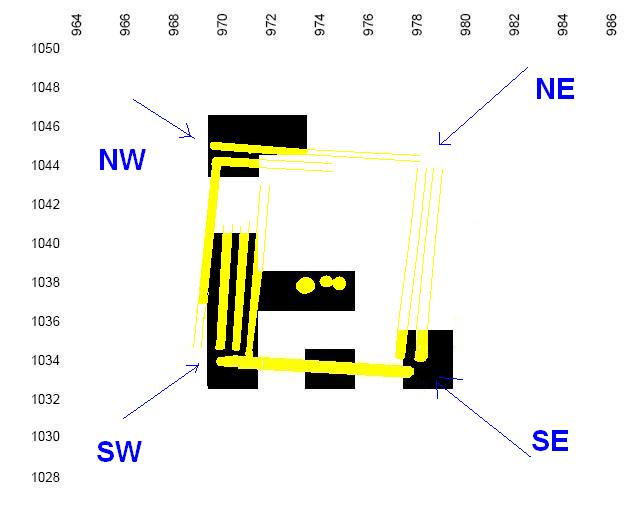
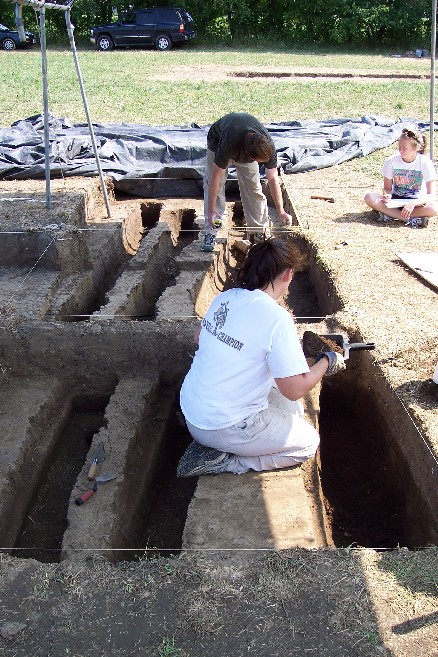
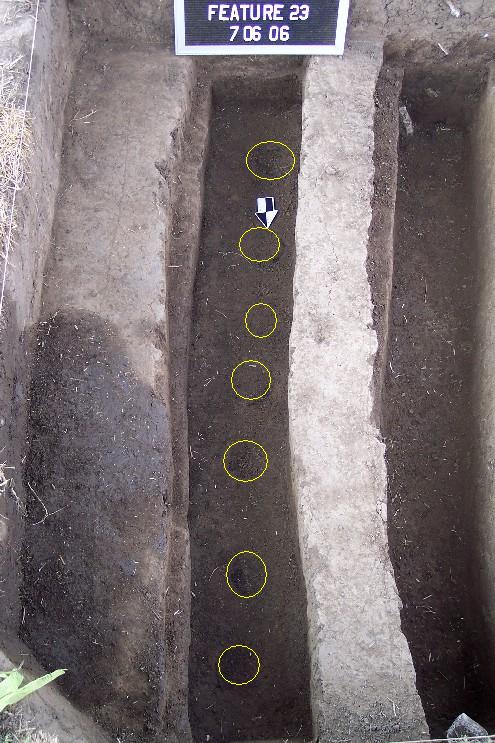
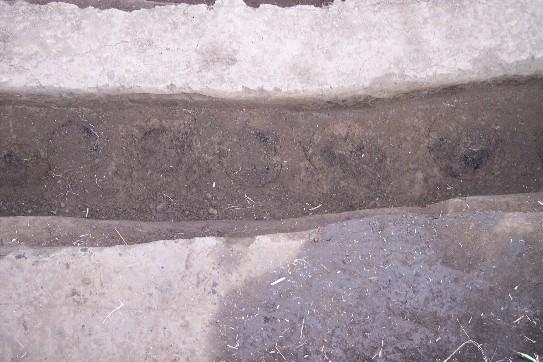
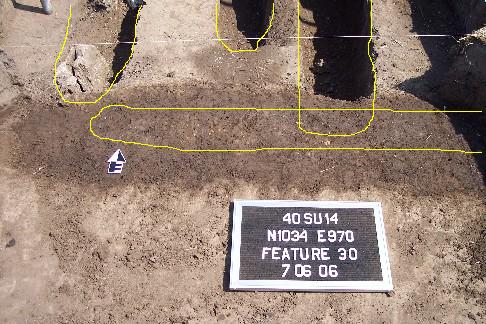



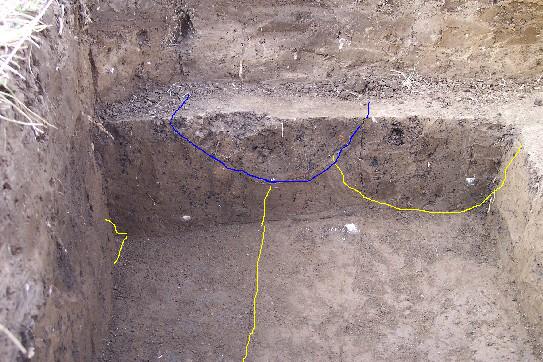
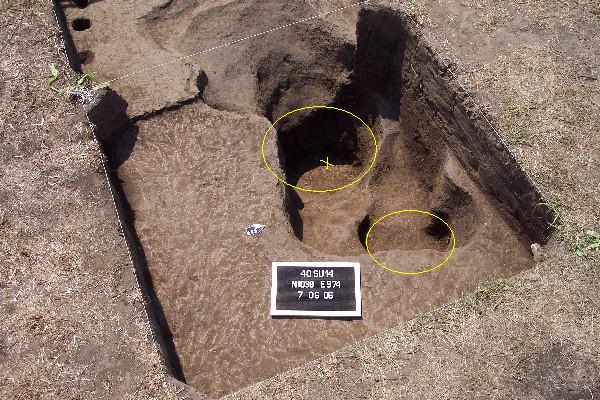
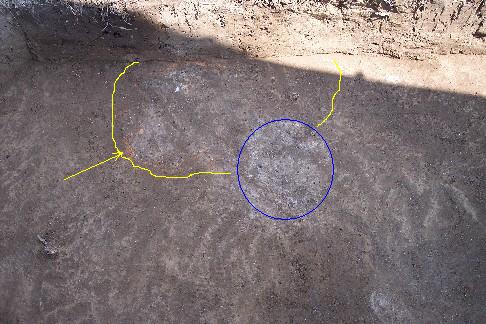
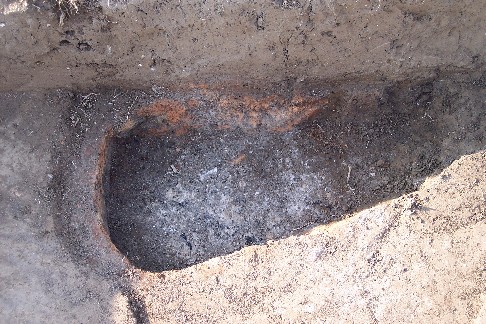
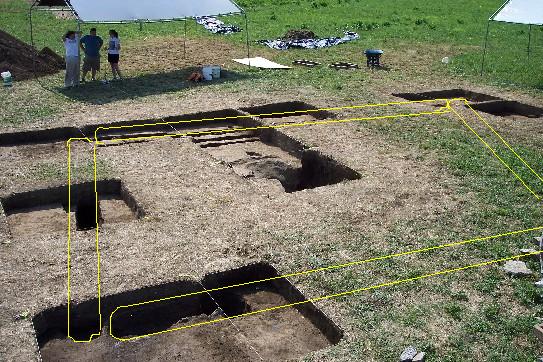
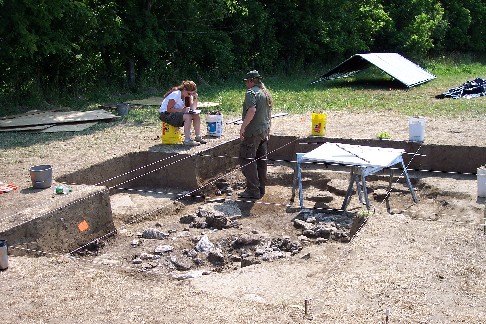
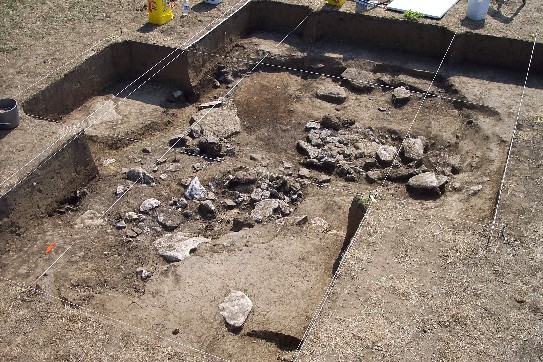
Another day of "perfect weather" for archaeology -- at least as far as
Tennessee in June is concerned! We really couldn't ask for better for the
last day of our project for 2006. But, we'll ask at least for the same
next year when we return for another summer dig :-) When Emily and I arrived this morning a bit after 7:00, we discovered
our white feral cat friend hunting his way across the field towards out
excavation units... While it might be a coincidence, we suspect he may
have internet access -- and was interested in our little bird mascot
mentioned on our web pages a few days ago. He fled on our drive-by. Thanks to the intensive work of our student crew today, we finished off
our excavations at the wall-trench house today. All of our careful
drawings and paperwork are completed, photographs done, and we're ready to
return these ancient features to the protection of their earth
covering. The photograph below is looking south along the west wall of this
building... While we have touched only a small percent of this building, we have
found all four walls and three of the corners. The same photo below shows
the west wall trenches in blue, the north wall trenches in yellow, and the
south wall trench in white. We'll retain these same colors through the
next series of photos... Looking towards the southeast, another angle on this building. The same photo below shows the south wall in white, the west wall in
blue, and the central support posts outlined in black. And finally, looking towards the east, a final angle on this
building. The same photo below shows the south wall in white, the west wall in
blue, the north wall in yellow, and the east wall in red. We're pleased with what we were able to uncover and discover
about this building in 2006 -- much more will remain for future
years. Over on the western edge, several of us worked our "hinies"
off -- as quickly as we could while still keeping up with our
records and doing full justice to this important feature from
circa A.D. 1250. We were able to complete a much better outline of
the feature by the end of the day. The 20 plus wheelbarrows of midden that we removed today from this
feature yielded an enormous amount of pottery, flint, and other artifacts.
And yet, with sadness, we were not quite able to finish every part of the
feature. It does seem to be a below-ground circular building with an
entrance on the east-southeast. The photo below shows the outline as
finished today. In order to finish out our excavation project today, we had to stop our
excavations here before we were completely finished -- we needed time to
do our maps, drawings, photographs and other recording. We'll come back
to this area in the future for further investigation. Behind the archaeological scene today, our crew members also finished
our "close-down" work -- dismantling our shelters and packaging them
carefully for next year's students. And getting our excavation units ready for backfilling. All of our
excavations will be filled back with the soil we removed to restore the
landscape to its appearance when we arrived. Below the ground, however,
our excavations are lined with plastic -- to mark these areas permanently
as places we have already investigated. The photo below shows several of
our excavation units as we left them today. Thanks to our friends the Garrotts, we have a front-end
loader at our disposal for finishing up the "heavy work" of
filling our excavations on Saturday morning. Although today was the last official day of our summer field class -- I
appreciate the many students who volunteered to show up for one more day
on Saturday to help with the backfilling. That extra effort gave us the
time to do justice to the important places and things we discovered this
summer. In only five weeks, we've discovered a great deal about this
ancient Tennessee Town. Thanks to the purchase of this site by the State
of Tennessee -- our tiny window will not be the last into this ancient
site before it is destroyed. Many years and decades of future students,
archaeologists, and interested citizens will be able to visit,
contemplate, and investigate the mysteries of what was the first "county
seat" of Sumner County. A great crew on a great project. And now -- we close off for Summer 2006. Check back with us again in
Summer 2007 for another project at Castalian Springs.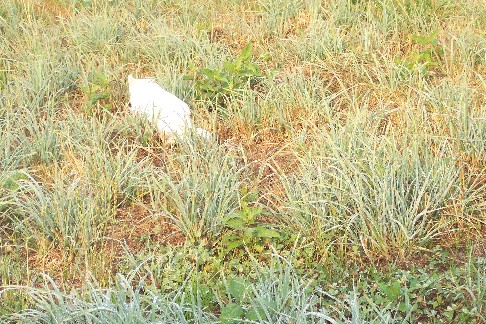
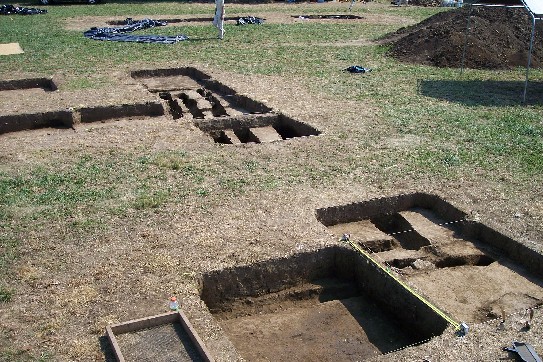


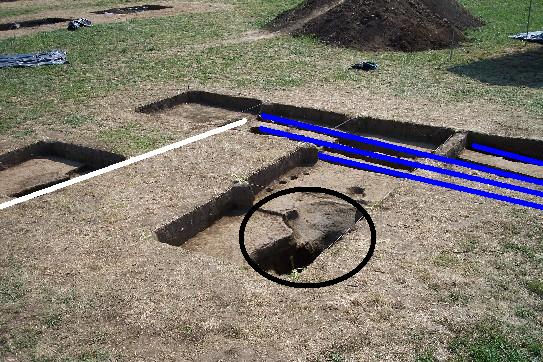




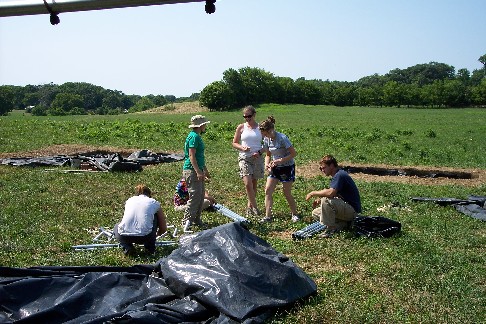

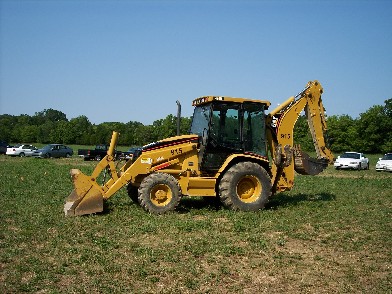
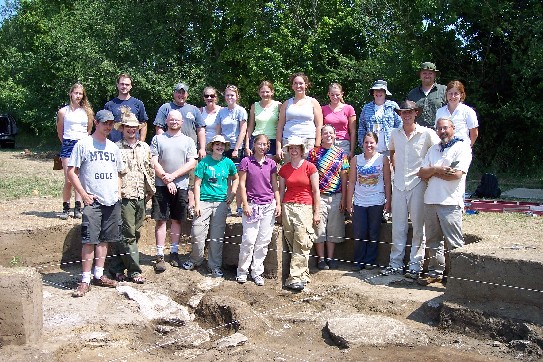
For those diehards who just couldn't resist checking one more time on the 2006 web pages -- a few shots of our team of volunteers closing out the site...
Before using the front-end loader to do the bulk of the filling of our excavations, we carefully protect the features we discovered from possible damage by the heavy equipment. This involves some hot, sweaty labor...
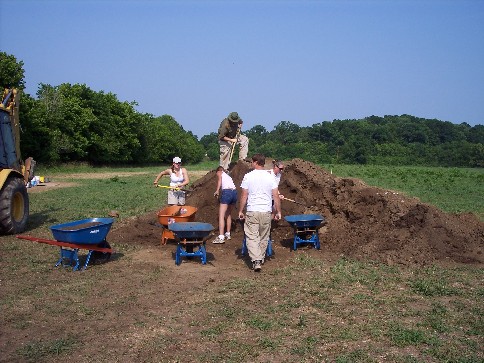
Below, the trenches of the house we discovered are being carefully filled by hand with clean dirt.

The bottoms of the units are then carefully lined with plastic. In the southwest corner of each excavation unit, we place a "message in a bottle" (outlined in yellow below).
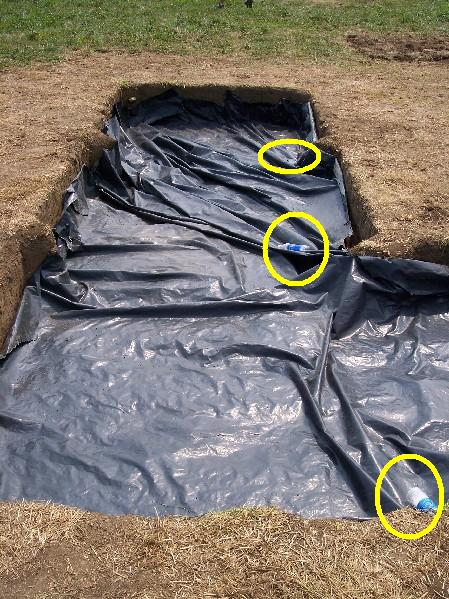
As shown from last year, these plastic bottles contain an archival tag with descriptive information about the excavation unit. These bottles have been a big help in the past when we came back to a site again and our benchmarks had vanished or been destroyed.

Then the backfilling began in earnest -- the photo belows shows the students spreading the dirt as I drive another bucketload in the backhoe.
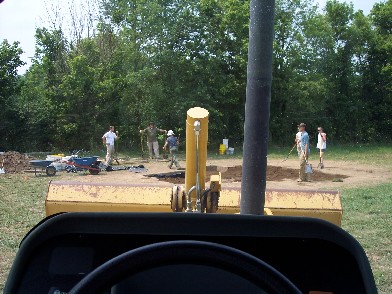
After the dirt is placed back in the holes, the sod that we carefully saved in a separate pile is spread over the units to help prevent settling and to discourage the growth of intrusive weeds in these areas. The photo below shows several of the units after they were "closed out."

We took a final trip to the top of the hill today to take a photograph of our site after we finished "cleaning up." On June 14, our excavations looked like this...

Today, as we left, the site appeared like this...
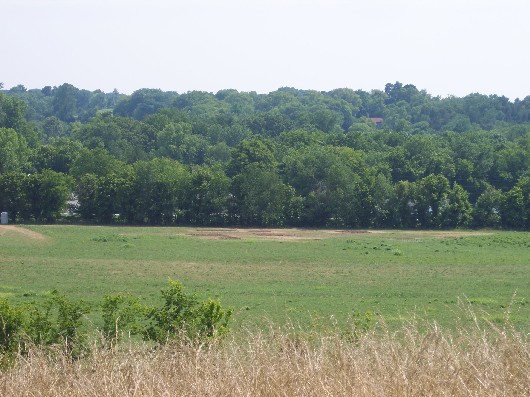
More news next year...